- Newsletter Issue Number:
- AICCM National Newsletter No 159 December 2022
International Conservation Services (ICS) Canberra
Over recent months, a number of ICS team members have been working at Old Parliament House (OPH) in Canberra to complete a range of conservation projects associated with the fire remediation works. The central project was conservation work on the OPH doors, which have been painstakingly conserved and restored in Sydney. The doors are now back in Canberra, taking pride of place in the refurbished front entrance of OPH.
Oliver Hull, assisted by Jan Walter and Mark Searle, spent many hours removing the burnt sections of the doors, and painstakingly scarfing in and matching new pieces of jarrah. All of the fittings were burnt and needed to be conserved and patinated, which was undertaken by Keir Bayley. ICS worked with a local engineering firm, Austec Engineering (in particular Les Harris) to fabricate and install many new and replaced door fittings and pivot mechanisms. Oliver and Jan brought the doors back to Canberra and worked with Doug Rogan and Manteena (Project Managers) to re-install the doors in late September.
Keir and Alis Jitarescu also cleaned and waxed the front handrails, two of which had been repaired and repatinated by Keir, and then reinstalled. And, a few months ago, the copper alloy-clad windows were cleaned and waxed by Keir, Wendy Reade and Amy Walsh, and the two painted coats of arms inspected. During these works, the refurbished external light fittings that had been conserved by Claire Rowson and Keir were reinstated. A further inspection of the central bronze coat of arms was also completed, following cleaning, repatinating and waxing undertaken earlier in the year by Keir.
On top of all of these external works, Alis and Doug Rogan undertook a major clean and trials of in-fills for the nearly 100-year-old rubber flooring in the downstairs Strangers Gallery. The floors were subsequently stripped and fully re-coated under ICS supervision. All of these projects were overseen by Doug Rogan, ICS’s Canberra Manager.

OPH doors reinstated after extensive conservation and restoration, and now open to the public.
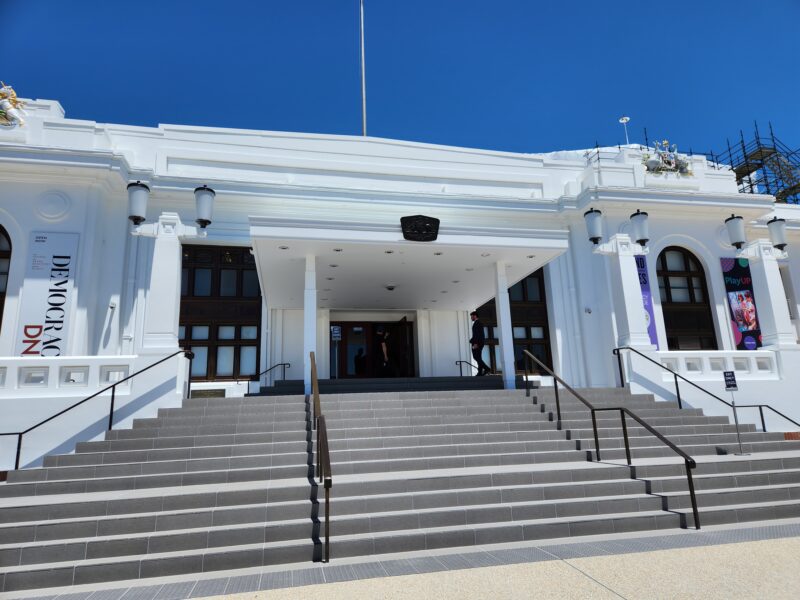
OPH façade showing windows, handrails, coats of arms, doors and lights, which were worked on by the ICS team.
National Gallery of Australia (NGA)
In October, the National Gallery of Australia celebrated its 40th birthday. To celebrate the special event the Australian and International gallery spaces were rehung and there was a massive weekend of talks and tours, and even an opera. The Conservation department has been working closely with Security to protect works of art and respond in the case of environmental protesters targeting artworks. The Gallery is also undergoing major capital works upgrades that require extensive input from the conservators, monitoring dust and environmental conditions, inductions for all contractors and contributing to risk management of all activities that pose risks to the collection.
The Objects Conservation section has been busy working on several concurrent projects from an Australian art rehang to overseeing the installation of new works in the sculpture garden. Urs Fischer’s wax candle sculpture Francesco has been installed in the foyer and Kim Goldsmith has been involved in drilling and lighting various wicks and maintenance for this work. Preventive Conservation installed a particulate and gas phase filtration system over the candle to mitigate the smoke risk. Alysha Redston and Courtney Crane travelled to Singapore for the installation and deinstallation of the travelling exhibition ‘Ever Present: First Peoples Art of Australia’.
In what has been a busy second half to the year, following the opening of the Gallery’s major Cressida Campbell retrospective, Paintings Conservation has been concentrating on fulfilling a busy loans program and enabling a significant round of gallery changeovers. They have also been closely involved in deinstalling ‘Ever Present’ at the National Gallery of Singapore prior to its move to Auckland Art Gallery.
Paper Conservation and Mountcutting have been preparing works in line with the NGA’s 40th birthday celebrations. These activities included conservation and mounting and framing of works for the Rauschenberg and Johns exhibition, and the Kara Walker exhibition. There has also been a return to display for Les Sauvages de la Mer Pacifique, one the first panoramic wallpapers of this scale—20 drops, over 10 metres in length. The wallpaper was manufactured in 1804–05 by Joseph Dufour et Cie, after a design by Jean-Gabriel Chervet. It comprises a highly stylised depiction of the peoples of the South Pacific. Over several months, further image reintegration was completed in Conservation, including overpainting of a 20-year-old photographic insert, which had become discoloured. At the same time, the Mountcutting and Framing section, in conjunction with NGA workshop staff, developed a prefabricated mounting and framing system that could be slotted in place to minimise construction around the vulnerable surface of the work. The work is now also fully glazed with Optium.

Paper Conservator Fiona Kemp working on Les Sauvages de la Mer Pacifique. Image credit: Andrea Wise.
Preventive Conservation has been working with numerous capital works projects at all phases to reduce risks to the collection. Current projects include LED lighting upgrade of all galleries, implementing a new Building Management System interface for climate control, façade glazing replacement, and solar panel installation.
Textile Conservation has recently installed nine Ballet Russes costumes in the new International galleries. It has been exciting to dress these fabulous costumes and see them out on display again. The team has also been busy preparing textiles for changeovers and a large loan of 12 Arthur Boyd tapestries travelling in early 2023.
Textile Conservation has also been involved in the costuming for the restaging of Justene Williams’ Opera Victory Over the Sun for the Gallery’s 40th birthday weekend. The opera had over 130 individual costume pieces made from a range of unusual materials, from marine carpet and neoprene to PVC and polypropylene. The costumes were collected as a concept with the intent that they would be worn and possibly remade for future performances. Assessing wearability, repairing, adjusting and fitting costumes to performers, as well as assisting with dressing during the rehearsals and performances was a very different approach to our usual way of thinking and conservation principles. We have all learnt a great deal with this fun project. The position of Textile Conservation Technician has been made a permanent role within the Textile team and has just been advertised.
Australian National Maritime Museum (ANMM)
Staff news
Even more interns!
Irene Theodore has come back to the Museum as a volunteer to finish off the work on the Rice Collection she started during her internship.
For four weeks over August and September, the Museum hosted Rory Hutchinson. Rory is a recent graduate of the Grimwade Centre for Cultural Materials Conservation and a Melbourne bartender who came to the ANMM as a volunteer looking to gain experience and learn some new skills. During his time here, Rory leant his hand to numerous conservation tasks including the maintenance of the HMAS Kara Kara engine, inspection and cleaning of our suspended Swimming (Zou Liang) sculpture, assessment and treatment of maritime archaeological objects from the wreck of the clipper Dunbar, waxing the bronze Windjammers Sailors (Brett Garling) sculpture, structural assessment of the Vietnamese refugee vessel Tu Do and reinstating the plaque on the entrance door of the Cape Bowling Green Lighthouse. His time with us culminated in his project management of the annual clean of the Tasman Island Light. We thank Rory for all the valuable work he has done with us and wish him the best of luck with his future endeavours.
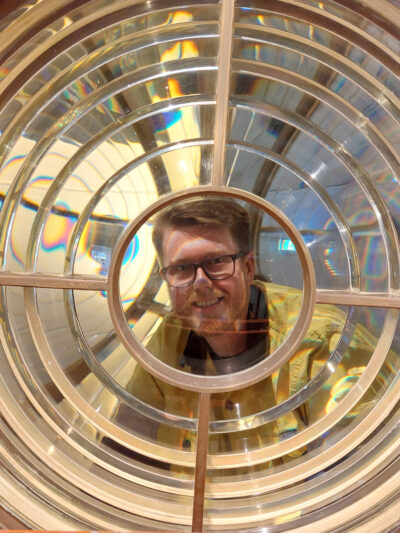
Rory’s head, as seen from outside the Tasman Island Light. Image credit: Nick Flood, ANMM 2022.

Rory’s trophy shot with his completed treatment of the lighthouse plaque. Image credit: Nick Flood, ANMM 2022.

Rory’s meets the Museum’s beloved dog, Bailey. Image credit: Nick Flood, ANMM 2022.
At the end of November, new interns Victoria Poppins and Carmilla Norman from Melbourne’s Master of Cultural Materials Conservation program started. Carmilla will be continuing work on the Dunbar shipwreck collection commenced by our previous interns, whilst Victoria will be working on plastics and rubber materials relating to bathing and swimwear. We welcome them to the team and hope they enjoy their stay with us for the next two weeks.
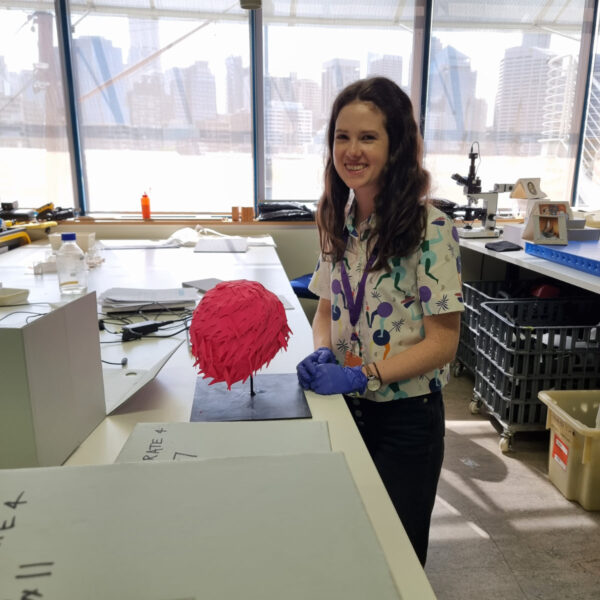
Intern Victoria with her project. Image credit: Jeff Fox, ANMM 2022.

Intern Carmilla with her project. Image credit: Jeff Fox, ANMM 2022.
MMAPSS
The week of 21–25 November saw the Museum host MMAPSS – the Maritime Museums of Australia Project Support Scheme – a partnership between the Australian National Maritime Museum and the Department of Infrastructure, Transport, Regional Development, Communications and the Arts. This annual outreach program provides grants and training to staff and volunteers at non-profit organisations that care for Australia’s maritime heritage. The aim of this week-long training course was to share knowledge, develop museological skills, make connections and build a sense of community amongst the maritime museums and heritage organisations of Australia. Senior conservators Nick Flood, Alayne Avis and Jeff Fox led the participants through talks and tours of the laboratory, informing them about preventive practices, conservation of maritime archaeological objects, conservation management plans, and First Nations com munity participation. Participants were encouraged to ask questions about how best to care for their own collections and were given one-on-one time during the end of the week to discuss any potential projects they may need help with.

Nick talking to the MMAPSS participants. Image credit: Jeff Fox, ANMM 2022.
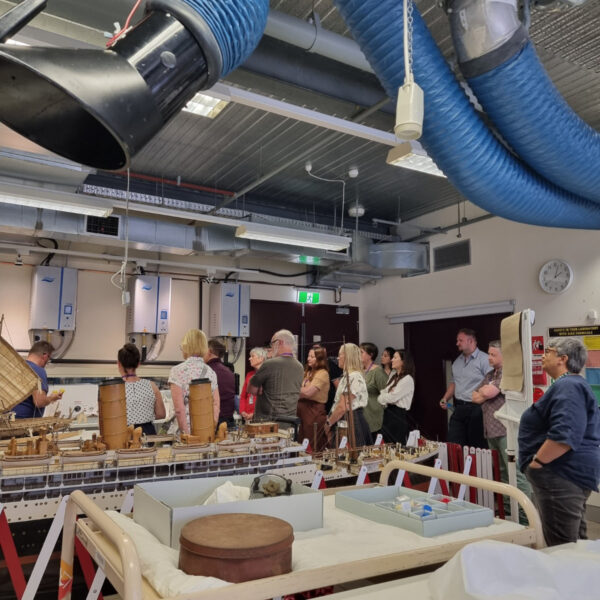
Jeff leading a tour around the conservation lab. Image credit Emma Hayles, ANMM 2022.
Jeff visited Darwin in September to meet with the Conservation team at the Museum and Art Gallery of the Northern Territory (MAGNT) to complete a condition assessment and conservation management plan for some of their First Nations watercraft collection. This visit formed the completion of an in-kind grant awarded to MAGNT through the ANMM Maritime Museum of Australia Project Support Scheme (MMAPSS).

Lauren Ravi, Assistant Conservator (MAGNT), and Jeff Fox, Senior Conservator Collections (ANMM). Image credit: Matt Poll ANMM 2022.
Jeff also visited the Buku-Larrŋgay Mulka Centre in Yirrkala, East Arnhem Land, to renew connections with the Yirrkala community and take part in a two-way knowledge transfer with the artists at the art centre. Jeff was privileged to be invited onto Yolŋu country to take part in ochre and bark harvesting with some of the artists, and in the bark preparation process in readiness for painting. This knowledge will better inform conservation management plans and decisions made as custodians of the ANMM Saltwater bark collection from this region.
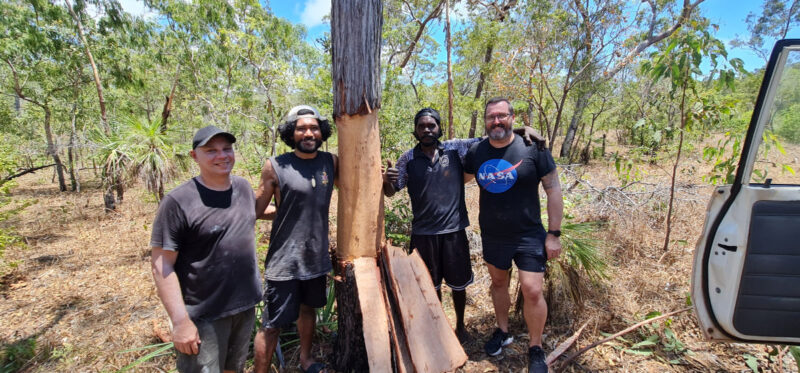
(L–R): Matt Poll (ANMM), Tyson Frigo (ANMM), Doŋga Mayamuru (Yirrkala Art Centre) and Jeff Fox (ANMM). Image credit: Yirrkala Art Centre (NT) 2022.

Jeff talking to staff at ANMM, informing them of the work he had undertaken. Image credit: Emma Hayles, ANMM 2022.
Collection Care
Under the direction of conservation manager Agata Rostek-Robak, new signage was placed around the conservation corridor so that tour groups and internal staff could gain a greater understanding of some of the principles of conservation. Highlighting preventive conservation, the posters inform about environmental parameters and pest management.
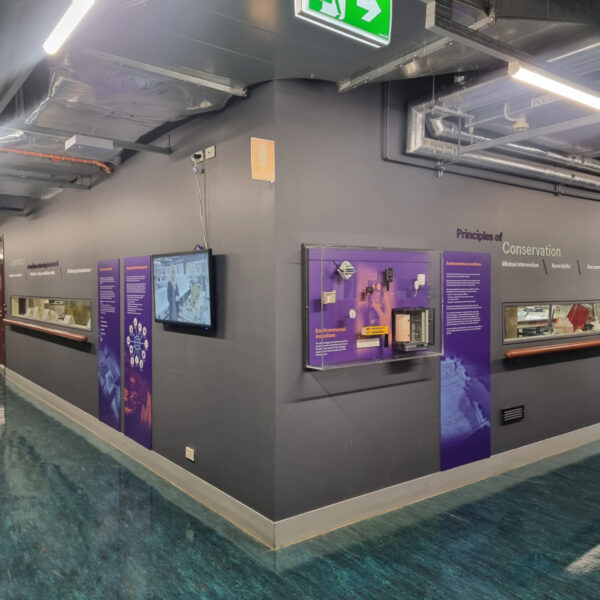
New corridor signage, with old environmental monitors on display. Image credit: Emma Hayles, ANMM 2022.
Large projects
Tu Do
Structural works are being planned for Tu Do, and the team met with Fleet member Jeff Hodgson to discuss how best to approach this. To make the vessel structurally stable, certain timbers need to be replaced, either partially or fully. Nick and Jeff are working together to determine which planks require replacement and which can be left. The slow process of mould removal on the interior has also commenced. The tight confines and the use of solvents mean that the progress is slow, and the windy days in Sydney have limited access.
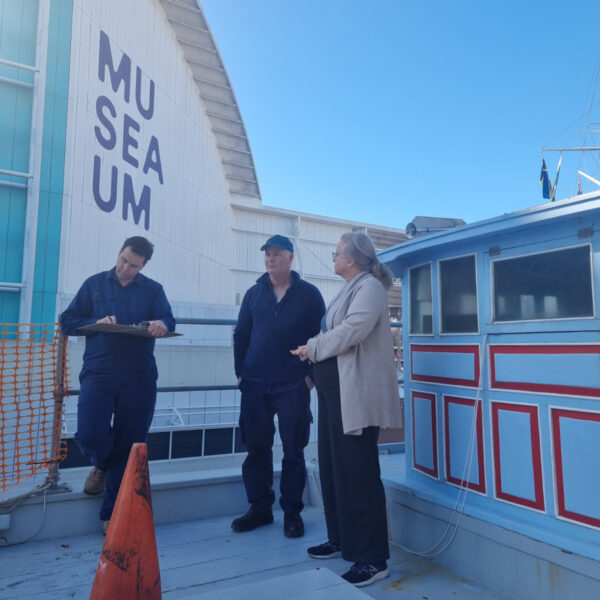
(L–R): Nick, Jeff and Agata on Tu Do’s decking. Image credits: Emma Hayles, ANMM 2022.
SS Orontes
Treatment of the SS Orontes ship-builder’s model is well and truly under way—the dry cleaning and wet cleaning have been (mostly) completed, with gentle humidification, flattening and consolidation of the decking started. Taking off nearly 100 years of dirt and grime has already given new life to the ship model. After a lively discussion with curators about next treatment steps and desired outcomes for display, the team can now start on stages such as replacing missing sections, re-attaching and re-integrating rigging, and removal of the overly glossy varnish.
In June and again in November, Nick Flood assisted Silentworld Foundation’s conservator, Heather Berry, during fieldwork on the wreck of the barque South Australian. In 1837, the South Australian was grounded in the shallow waters of Encounter Bay, South Australia, making it the state’s oldest known European shipwreck. Heather and Nick’s work included the documentation of the wreck and its condition, sampling the ship’s timbers and assessment of small finds.

Silentworld’s vessel Maggie III departs for the wrecksite of the South Australian in Encounter Bay, South Australia. Image credit: Nick Flood, ANMM 2022.
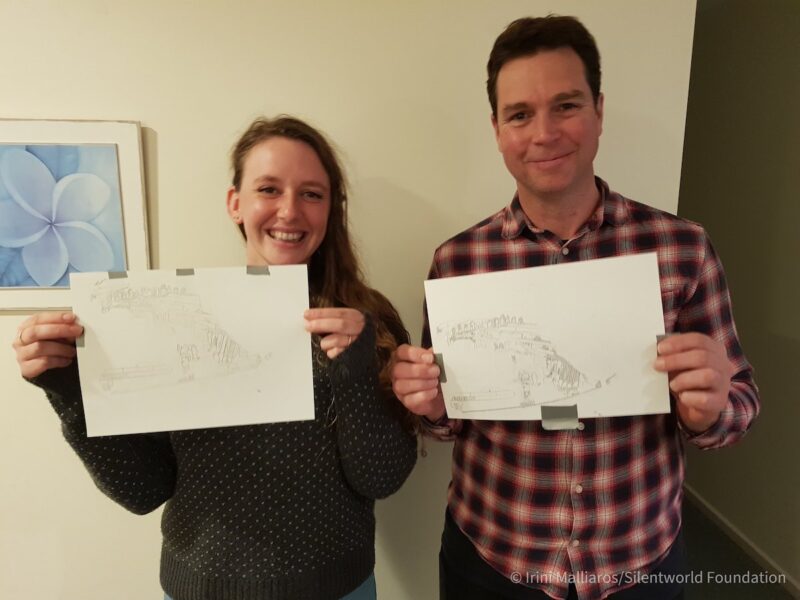
‘Two very proud kindergarteners’, Heather Berry (Silentworld Foundation) and Nick Flood (ANNM) showing off their site plans. Image credit: Irini Malliaros, ANMM 2022.
Exhibitions
Wharfies’ Mural
One of the Museum’s most iconic treasures, the Wharfies’ Mural, is now on display for the first time to mark the 150th anniversary of the Maritime Union of Australia. The mural, painted between 1953 and 1993, depicts life on the waterfront and has become a symbol of the fight for workers’ rights and social justice. Jeff and Alayne worked together to prepare the mural for installation, with Kevin Bray being key in developing a hanging system for the heavy mixed-media-on-reinforced-plaster works. The mural had been treated previously but required extensive condition reporting to ensure it was suitably stable for long-term display.
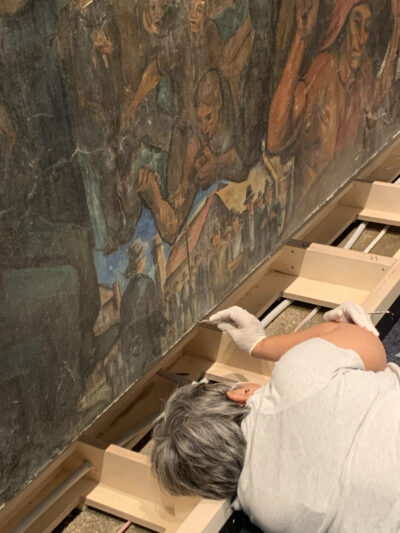
Alayne carefully consolidating an edge of the mural in-situ. Image credit: Agata Rostek-Robak. ANMM 2022.
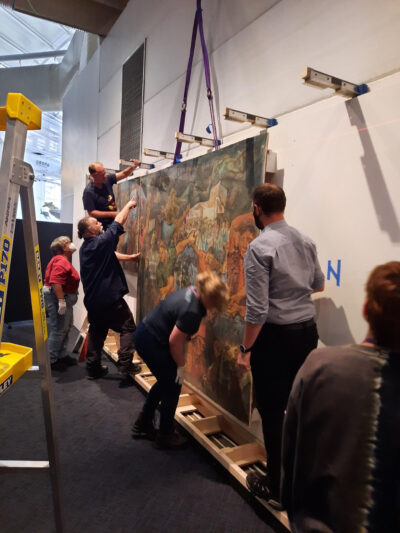
The mural parts being forklifted into place. Image credit: Richard Wood, ANMM 2022.
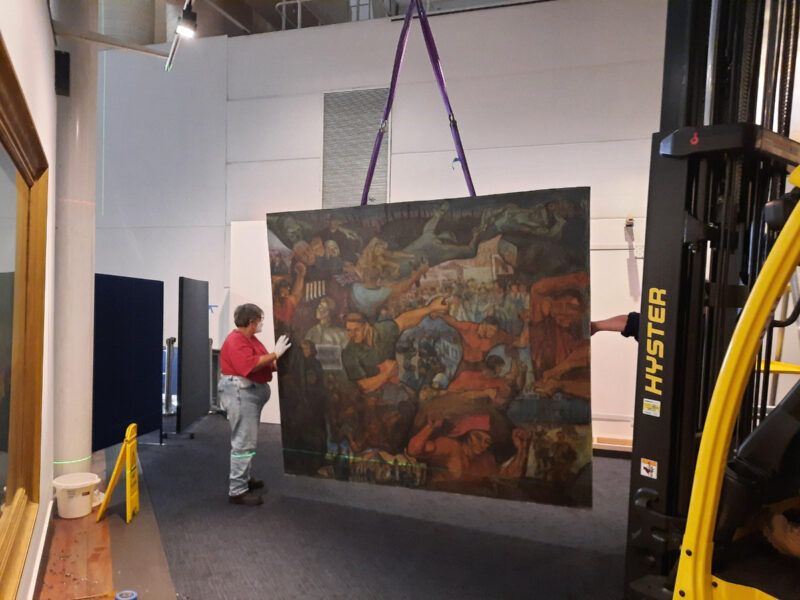
The mural parts being forklifted into place. Image credit: Richard Wood, ANMM 2022.
Endeavour cannon
Jeff headed the installation of an HMB Endeavour cannon and other archaeological finds in the Tall Gallery. Whilst treatment was not required for the objects, the cannon, weighing a whopping 560 kg, had to be adequately supported and the installation carefully planned.
Punchbowls
The ANMM’s and SLNSW’s Sydney punchbowls have been reunited for an exhibition at the Museum. These significant ceramic vessels each depict differing panoramas of Sydney from the period 1810–1821. Ahead of the exhibition, the ANMM Conservation and Digital teams worked together to undertake technical imaging of our punchbowl. Reflectance Transformation Imaging (RTI) was used to reveal a ‘missing’ monogram, and photogrammetry to reproduce the object digitally (View the 3D model on Sketchfab here).

Emma and Nick during the capture phase of the Reflectance Transformation Imaging (RTI) of the ANNM Punchbowl. Image credit: Leonie Jones, ANMM 2022.
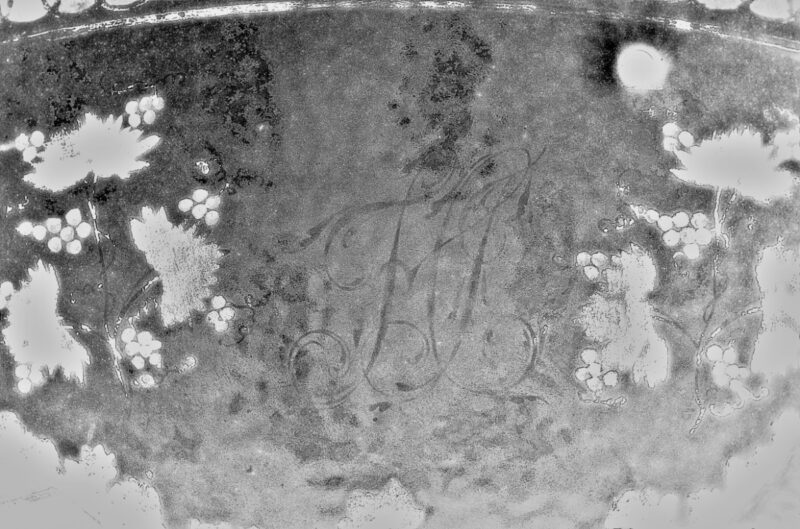
RTI detail of the ‘missing’ monogram from the ANMM Punchbowl. Image credit: Nick Flood and Emma Hayles, ANMM 2022.

Image capture of the ANMM Punchbowl for photogrammetry. Image credit: Nick Flood, ANMM 2022.

Photogrammetry model of the ANMM Punchbowl. Image credit: Snow and Jasmine Poole, ANMM 2022.
Brickwrecks
Alayne is hard at work preparing objects and loan objects for our next exhibition scheduled for mid-December. The exhibition is a combination of Ryan ‘The Brickman’ McNaught’s stunning LEGO® models, plus real shipwreck objects, hands-on interactives and audio-visual experiences that bring to life shipwreck stories.
Conferences and courses
Barangaroo Boat Outing: The team was lucky to head out to Silentworld’s headquarters for a day of lectures and workshops about the Barangaroo Boat Project. The team was very impressed by the work being undertaken and enjoyed the insight into how this fantastic piece of Sydney’s history is being conserved.
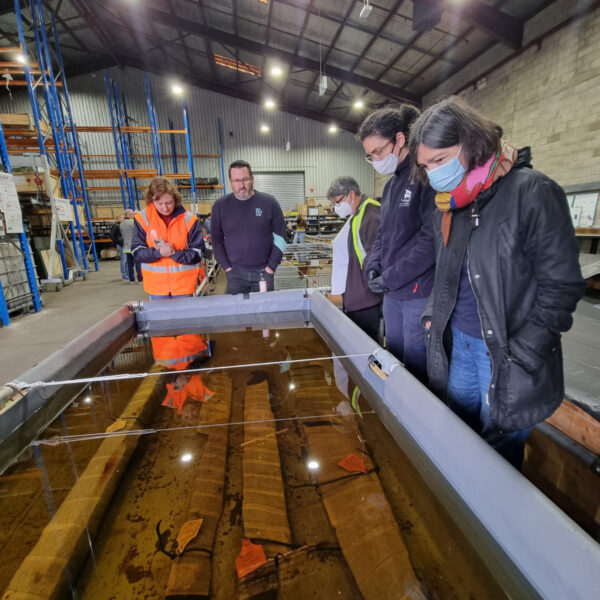
The team, cold but happy learning about the Barangaroo Boat Project. Image credit: Emma Hayles, ANMM 2022.
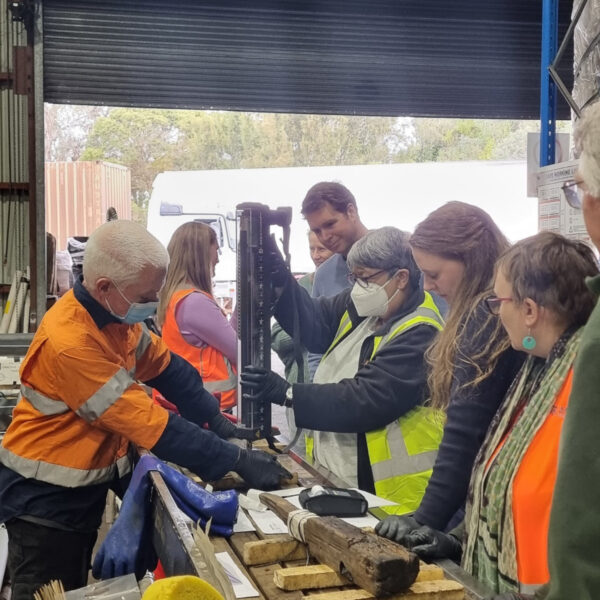
The team, cold but happy learning about the Barangaroo Boat Project. Image credit: Emma Hayles, ANMM 2022.
Nick Flood was excited to attend the Big Stuff 2022 conference held over two days in September from the historic industrial town of Seixal, Portugal. For Nick, it was, in reality, a two-night conference from his living room.
Australian Museum Collection Care and Conservation

The CC&C lab is alive with activity towards the end of 2022.
Staff changes, Professional news
We farewell a team member—Lucy Tedder is destined for Canberra, taking up a new position at Parliament House as its Preventive Officer. She will be greatly missed in the office and in the lab.
The CC&C team recently confronted and conquered their fear of heights through some healthy exposure therapy. With the full team support, we all signed up for EWP yellow ticket training and despite windy inclement weather we all managed to get the boom up to its highest point. We passed with flying colours and are ready to take on any height-related challenge (below 13 metres). Thanks to Yalagan for the safety training (and free therapy).
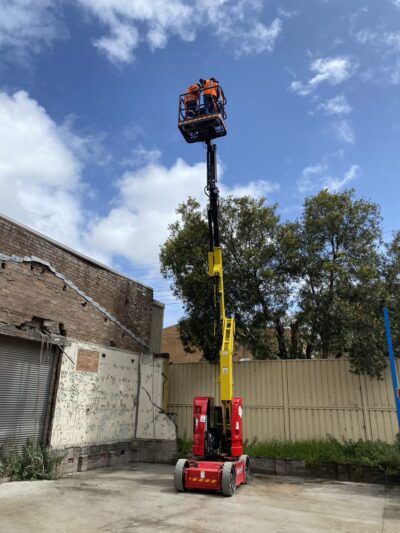
Staff members going All The Way Up with EWP training at Yalagan safety training in Alexandria.
Treatment project
Clare Kim and Silvia Da Rocha have been undertaking the re-construction of four leatherback turtle skulls in collaboration with the Herpetology department and Katrina McCormick in Taxidermy. These skulls arrived in Conservation in several pieces after being prepared in warm water to de-flesh and remove biological material. The puzzle pieces were then carefully reunited , before finally being housed in archivally accessible new homes.

The leatherback turtle skull in several parts before treatment. Above Image credit: Silvia Da Rocha.

The leatherback turtle skull after treatment. Image credit: Silvia Da Rocha.
Collection enhancement project
Exhibitions
The new Minerals Gallery installation is currently in full swing. The project has been ongoing for the past year and a half, with roughly 2,000 specimens processed through the conservation lab, and around 1,800 of those currently being installed (after cuts due to space constraints, sadly).
The specimens going on display have been chosen from across the Mineralogy and Petrology collections and are some of the most valuable specimens held at the AM. Having formed in various ways and locations – deep in the earth, inside volcanoes, or impacting with the earth from outer space – these weird and wonderful specimens often have complex chemical and physical properties, so they pose a range of interesting conservation considerations when treating and displaying them. Some require microclimates for display, some interact negatively with each other, and some are even light sensitive. Many are also extremely fragile such as the crocoite specimen pictured, which has long delicate, needle-like crystals on a matrix of gossan, which is crumbly and friable.
Treatments have been interesting and at times quite challenging, but the minerals team has absolutely loved working on the project, and we are all very proud to have been part of getting these beautiful specimens on display!

Crocoite specimen from Dundas Tasmania, which will be on display in the new Minerals Gallery at the Australian Museum.
The ‘Sharks’ exhibition installation has finally FINished and went swimmingly! The exhibition has seen record attendance, especially during the rainy school holidays. The life-size models of sharks and interactives have been a huge hit, and Bruce, the giant great white shark out the front of the Museum entrance, has been greeting everyone on College Street.
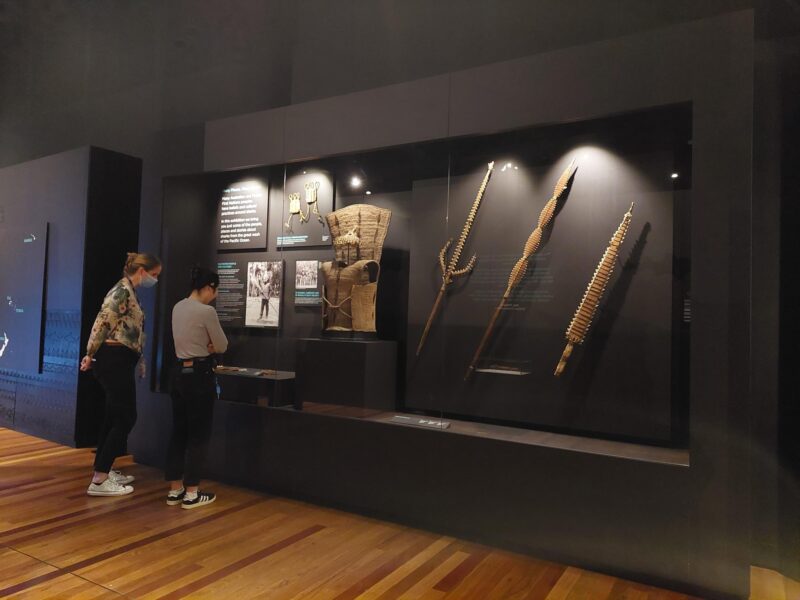
Conservators Lizzie Reed and Kyra Kim inspect the Kiribati Island case in the ‘Sharks’ exhibition. Image credit: Silvia Da Rocha.
Collection Care
Rehousing projects are underway at the Castle Hill off-site store, focusing on 12 large objects from the Pasifika Collection and a collection of 250 spears from the Pasifika and First Nations Collections. A bespoke storage unit is being designed for the spears, some of which are exceptionally long, whilst some of the tallest stillages this team has seen have been built to house some very tall objects from the Pasifika Collection.
The Museum has developed new lighting guidelines based on microfadeometer results from other museums (we are very grateful for the sharing of information). The produced guidelines will assist in more nuanced display considerations for the collections and more data collection (who doesn’t love that).
The spring and summer pest season is well and truly underway with a few prickly pest issues discovered around the Museum. Luckily, the team dealt with them quickly and had some fun along the way!
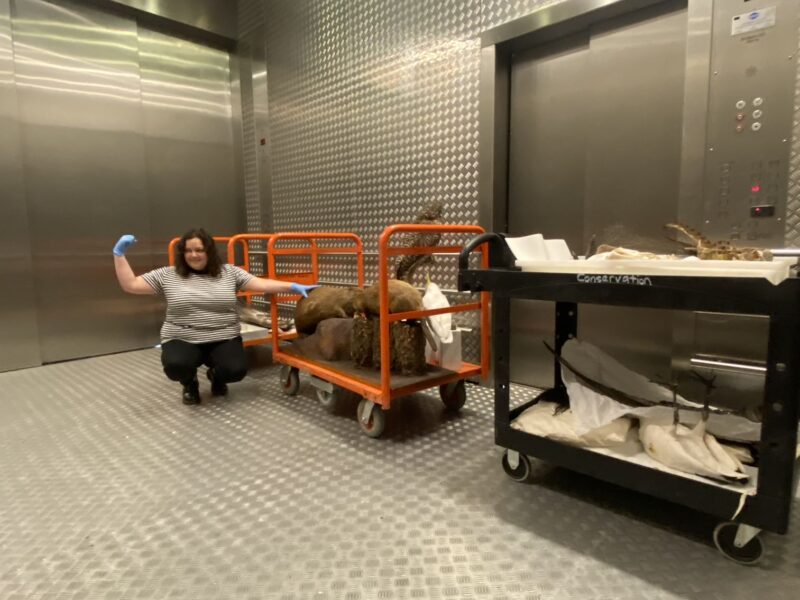
Conservator Silvia Da Rocha proclaims victory over pests in the AM loading dock. Image credit: Rehan Scharenguivel.
David Stein & Co
Staff updates
The end of 2022 is proving to be an exciting time of change and renewal at David Stein & Co. Key staff are departing to take up exciting new challenges and opportunities. We have recently welcomed new conservators who bring a wealth of experience and knowledge to our studio team. However, we are very sad to be saying goodbye to some very valued members of our team.
Lily Monk left the team in October to take up a position as Paintings Conservator at the Museum and Art Gallery of the Northern Territory in Darwin. Selina Halim has accepted a position as Senior Paintings Conservator at the Art Gallery of NSW, Sydney, commencing in December. Julia Sharp is stepping away from her role as Conservation Manager in order to focus on conservation initiatives and projects that have been in the planning for some time. She will remain affiliated with David Stein & Co in a consulting role. We congratulate Selina, Lily and Julia on their new roles and wish them the very best.
Two of our conservators are expecting babies and will be taking maternity leave for the duration of 2023. Sandi Mitchell’s baby is due in early December this year, and Ellie Gifford’s early in 2023. We wish them both the very best and look forward to meeting their lovely babies soon.
Maddy Fraser, a current paintings conservation student at Melbourne University, has joined us for three weeks for an internship.
We are very pleased to welcome our newly appointed Painting Conservators, Anna Don and Jessica Walsh, to our team. Anna, a graduate of the Hamilton Kerr Institute and City and Guilds of London Art School, was the recipient of a two-year Patrick Lindsay Fellowship at the National Gallery London. Jessica, a graduate of the University of Melbourne conservation program, comes to us from Grimwade Conservation Services and the Museum of Applied Arts and Sciences. They have impressive conservation experience and credentials and will be valuable additions to our team.
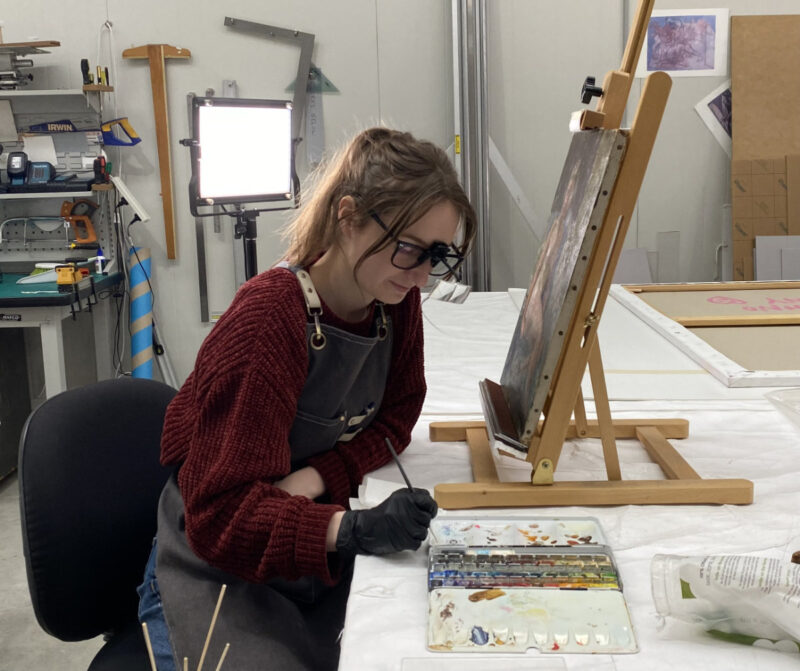
Our current intern from the University of Melbourne, Maddy Fraser, putting the final retouchings on an early 20th century life study.
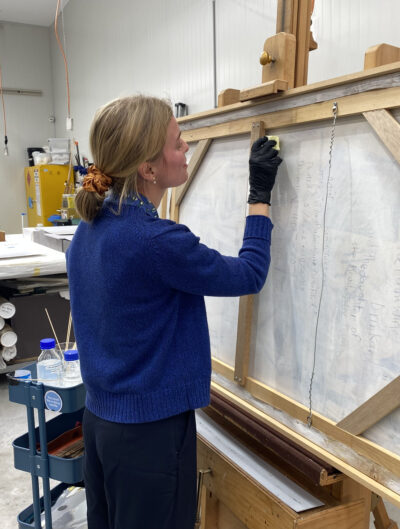
Painting Conservator Anna Don removing surface dirt from the verso of a painting.
In the studio
We continue to receive mould-damaged artworks in addition to our usual intake of conservation treatment work. The legacy of months of wet weather has meant that mould remediation will be part of our normal routine well into the new year. Jordan Wilson Aarsen and Selina Halim have undertaken research into the use of enzymes for the treatment of mould. We have already been using enzyme treatment as part of our usual mould remediation work, but difficulties in sourcing the active ingredients have prompted us to search for alternatives. With his background in organic chemistry, Jordan is well placed to undertake this research, currently in development. We look forward to the outcome. Selina and Jordan recently held an in-studio professional development workshop on the treatment of mould with enzymes.

Graduate Painting Conservator Jordan Wilson Aarsen presenting a workshop on enzymes for mould remediation.
We continue to hone our mist lining technique. In September, Monica Renn successfully carried out a mist lining on a delicate early 20th century still life painting. She first repaired the tears in the canvas and then the lining provided a gentle structural reinforcement of the support. Recently, Kim Vernon also undertook a successful mist lining to a 19th century portrait. Deformations and damages were repaired prior to lining, with the lining conforming to the original canvas and providing a gentle nap bond. Our next mist lining will be of an artwork on a deteriorating fine cotton canvas support.
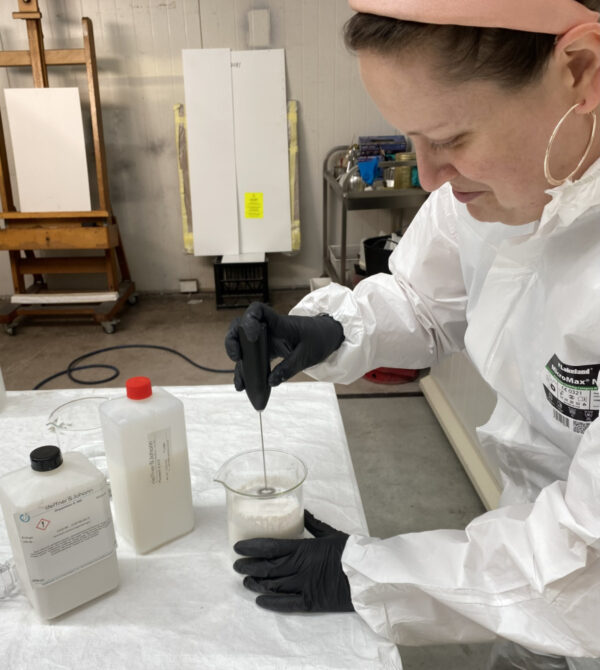
Painting Conservator Monica Renn preparing adhesive for mist lining.
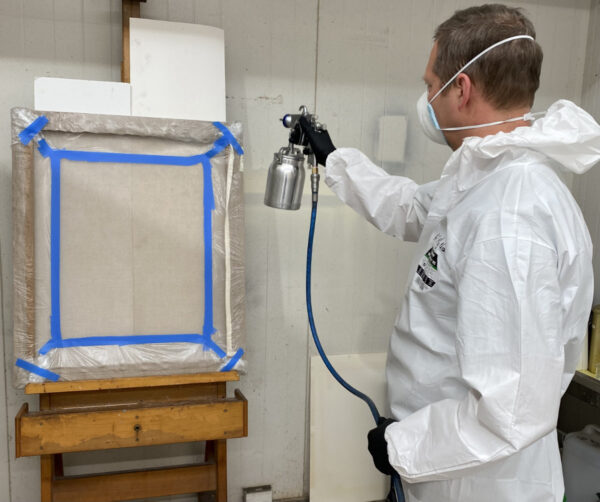
Painting Conservator Kim Vernon applying adhesive to lining canvas in preparation for a mist lining.
Sandi Mitchell has been working on a large painting by William Robinson, consolidating the very fragile and friable paint film, as well as a group of five Greek icons. Selina Halim recently removed very discoloured varnish from two early Italian paintings from the University of Sydney, part of a cycle of the Trials of Hercules. Selina and Lily Monk successfully completed structural treatment to the William Robinson painting that they have been working on for some time. Kim Vernon has been using our studio-designed nebuliser to consolidate powdery and flaking paint on an early artwork by a significant First Nations artist.
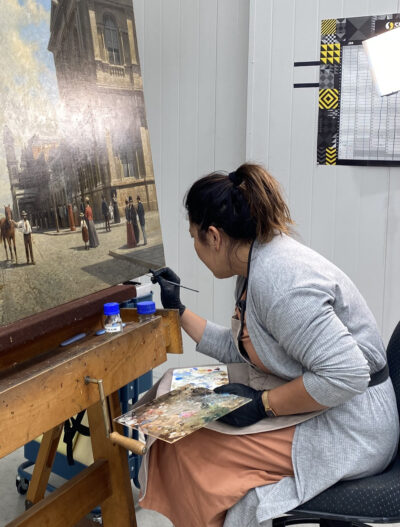
Senior Paintings Conservator Selina Halim carrying out the final retouching to a 19th century European painting.
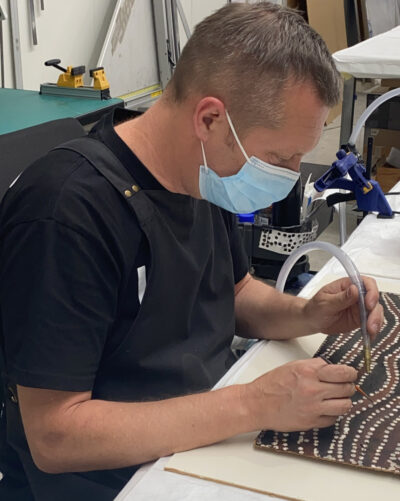
Painting Conservator Kim Vernon consolidating a fragile matte paint film using the nebuliser.
David Stein & Co have been engaged by NSW State Parliament to carry out conservation treatment to several key paintings while parliament is in recess. Several very large portraits are to undergo comprehensive treatments in the studio in the next few months.
David Stein, Kim and Jordan are working on-site on a mould remediation project at Sydney Town Hall. Recently, Ellie Gifford has been at Bundanon working on the Arthur Boyd collection.
We have continued our in-studio professional development workshops. Thus far we have covered framing, photography, report writing, and enzymes for mould treatment. Following her trip to Carlisle in the UK and attendance at the Modular Cleaning Program (MCP) Workshop at the Fine Art Restoration Company (FARC) with Chris Stavroudis, our intern Maddy Fraser presented a mini MCP workshop covering aqueous cleaning. Upcoming workshops include tear repair and micro emulsions.
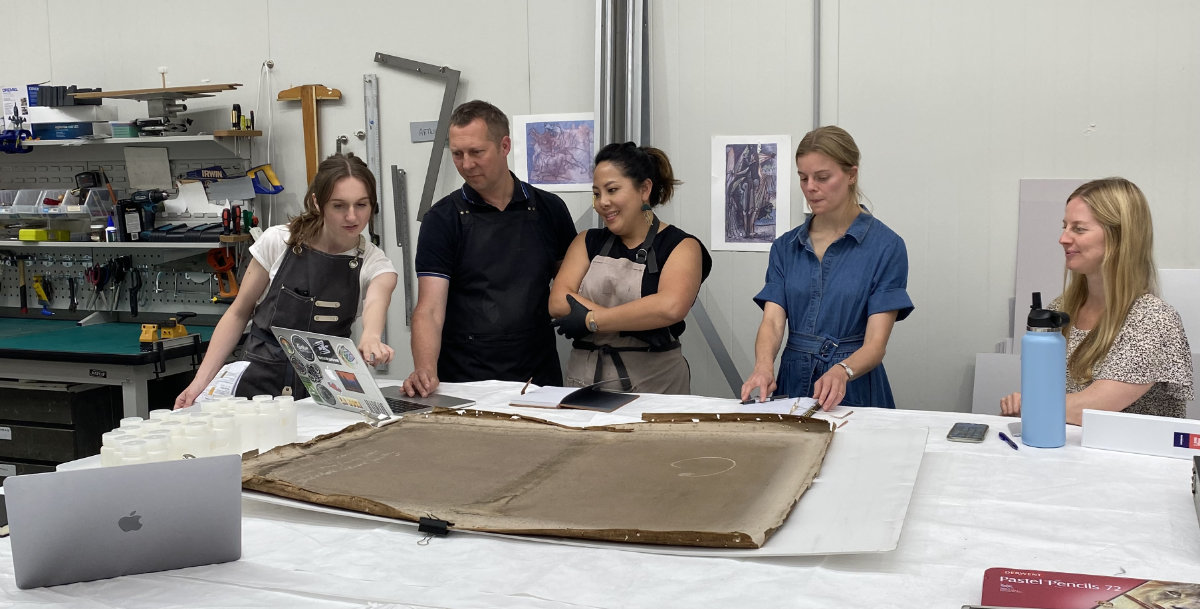
Painting conservation intern Maddy Fraser presenting a mini in-studio professional workshop on the Modular Cleaning Program (MCP).
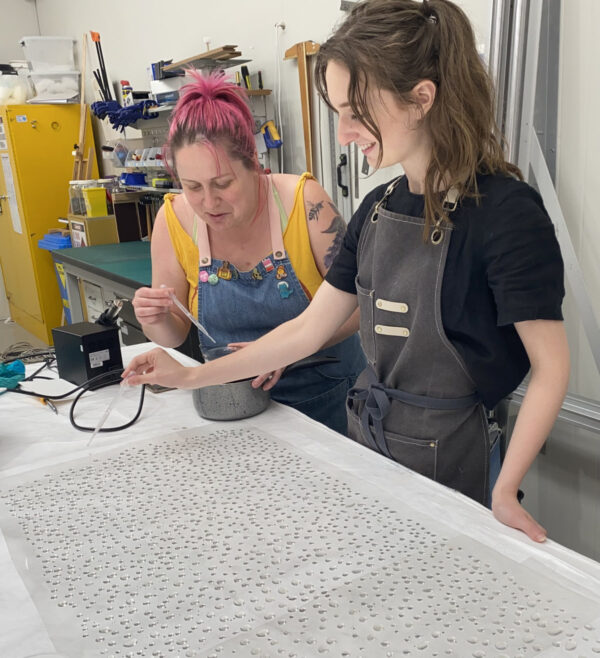
Monica Renn and Maddy Fraser preparing isinglass adhesive.
At David Stein & Co, the team is looking forward to the upcoming festive season, New Year and holiday break. We wish everyone all the best for the holidays and 2023.
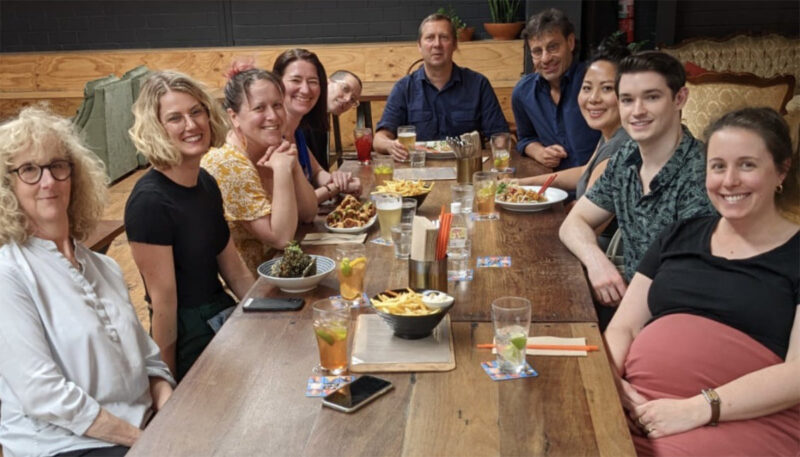
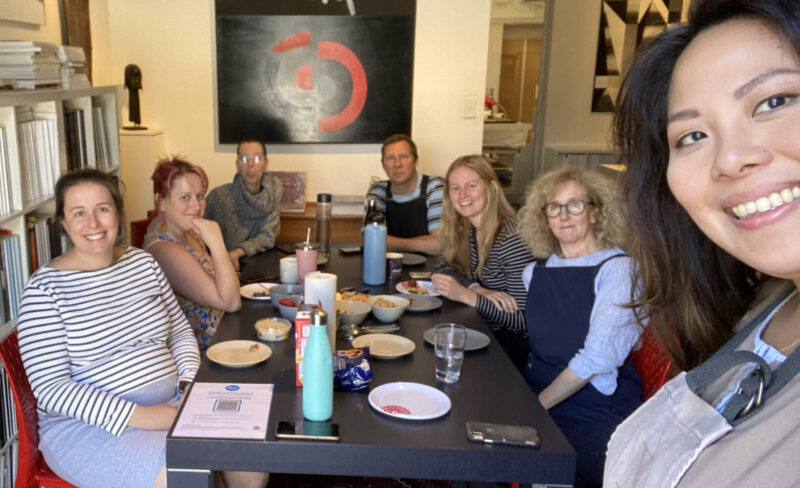
The team at David Stein & Co wishes you all the best for the festive season and New Year.
International Conservation Services (ICS)
Paintings
The conservation of the Lismore Regional Gallery collection damaged in the March 2022 floods continues at the ICS temporary conservation lab established by Create NSW at the former Registrar General’s Building next door to Hyde Park Barracks. Suati Rojas has been leading the ICS team there, and has been joined by Francesca Elia, Maria Vicente and Bianca Goncalves. There has been a lot of interest in our work on this project, including a visit from Premier Dominic Perrottet and Arts Minister Ben Franklin. We were also glad to host a visit from Lismore MP Janelle Saffin in October. Unfortunately, it was recently announced that the building will soon be demolished to create the new Queen Elizabeth II Plaza connecting Macquarie Street and the Domain, so we are on a tight schedule to be complete by early in 2023.
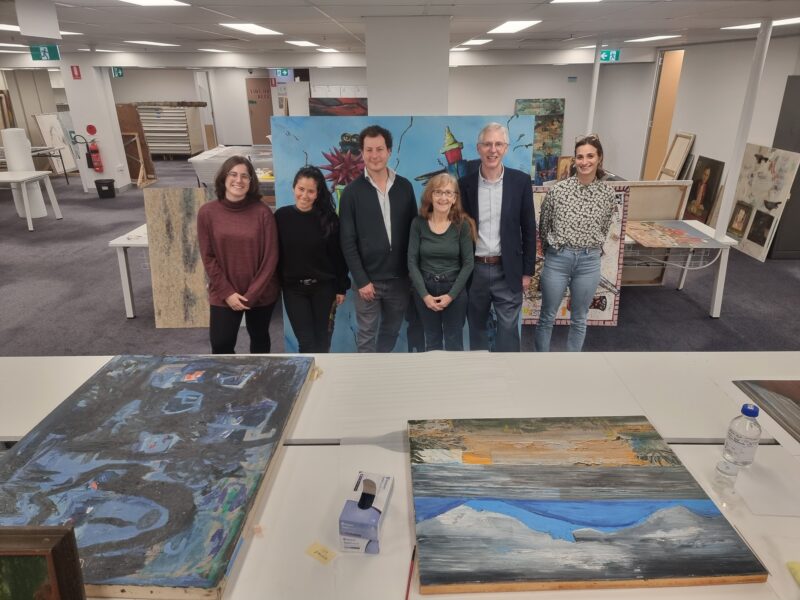
Lismore MP Janelle Saffin (centre) with Suati Rojas, who has been leading the ICS team there, and been joined by Francesca Elia, Maria Vicente and Bianca Goncalves. Image credit: Alexander Weilsmann.
Back at the ICS lab, the whole Paintings Team has been kept busy with a large number of very flaky paintings. Matteo Volonte, Claire Heasman, Eden Christian, and Suati all worked on many of the artworks in the exhibition ‘Prized Possessions’ at the National Trust of NSW SH Ervin Gallery, which included the recently revealed Dutch masterpiece. During the significant conservation treatment of the Hedda Banquet Still Life over many months, two signatures were identified, which eventually led to the painting being authenticated as a genuine Gerett Willemsz Hedda.

Claire Heasman, working on Banquet Still Life by Gerett Willemsz Hedda.
Textiles
Inside the Sydney Opera House was presented on ABC TV over three episodes in November, and featured work that Christina Ritschel and Julian Bickersteth have been undertaking on the John Coburn tapestries along with Kristen Phillips and Mary Anne Gooden from Artlab. Episode 3 includes a memorable quote from Kristen, which you will have to view to discover!
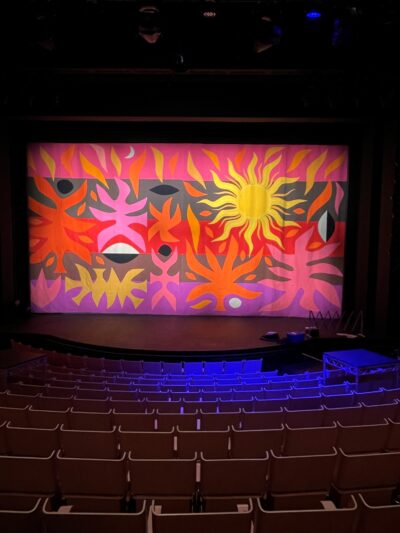
Curtain of the Sun, John Coburn tapestry after conservation, Sydney Opera House.
Christina and Julian are also working on the installation of a vast tapestry at the new Walker Building in Parramatta Square. Woven at the Australian Tapestry Workshops (ATW) in Melbourne, and measuring 6m x 11m, it is the largest tapestry the ATW has produced since weaving the Arthur Boyd tapestry in 1984–88 for the Great Hall at Parliament House, Canberra.
Objects & Outdoor Heritage
ICS was engaged to undertake the conservation treatment of the bronze and copper alloy components of the Archibald Fountain in Hyde Park, Sydney, with treatment taking place both on site and in the lab between August and November 2022. The 1932 fountain is by renowned French sculptor Francois Sicard and commemorates the association between Australia and France in World War I.
The bronze and copper alloy features of the fountain exist in a relatively harsh environment, which impacts their condition. As an outdoor monument, the fountain is subject to environmental factors such as weather, wildlife (e.g. bird droppings) and public access. The constant exposure to treated water from the fountain elements increases the level of corrosion and build-up of white scale accretions. Conservation treatment included a final application of microcrystalline wax to provide a stable protective layer against many of these environmental factors.
Conservation treatment works were a big team effort, undertaken by Wendy Reade (Principal Conservator, Objects and Outdoor Heritage), Amy Walsh (Objects Conservator), Keir Bayley (Heritage Trades Specialist), Kristina Taylor (Objects Conservator), Isabelle Legg (Graduate Conservator), Richard Isaacs (Conservation Technician), Alis Jitarescu (Senior Conservator), Isabelle Waters (Conservator), Shrief Eissa (Conservator) and Felix Fenely (Conservation Assistant).

Before treatment: the sculpture of Apollo, Archibald Fountain, Sydney. The sculpture of Apollo sits atop the central granite pedestal of the fountain.

After treatment: the sculpture of Apollo, Archibald Fountain, Sydney
Paper
The Paper Team has been inundated with mould jobs (pardon the pun) , with many collection items affected by mould and water damage from the recent floods and rain. We’ve also had an unprecedented number of pastels works in the lab over the last few months. Katie Wood has just finished working on an 18th century John Russell pastel portrait of Colonel Thornton with a hawk, which was suffering from mould and tears, and Caroline Whitley in tackling another very tricky pastel portrait featuring fragile paper and a large horizontal tear across the centre. Caroline has also just successfully completed the treatment of a large panorama platinum print of Sydney Harbour in 1903, which had many impact holes and tears. Both of these highly delicate projects, plus another three, benefited from the knowledge and expertise of Kay Soderlund and Kim Morris.
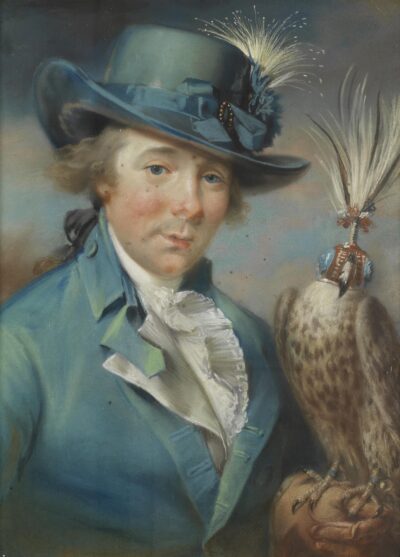
Before treatment, John Russell (Guildford 1745–1806 Hull) Portrait of Colonel Thornton with a hawk.
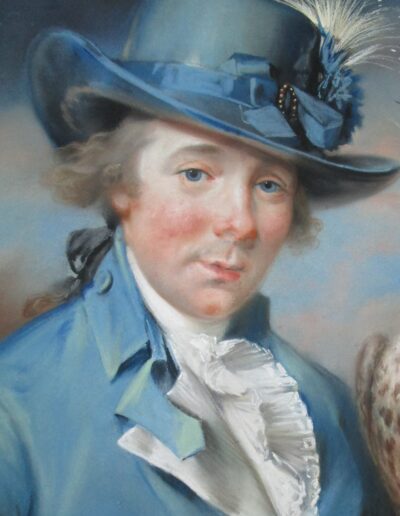
After treatment, John Russell (Guildford 1745–1806 Hull) Portrait of Colonel Thornton with a hawk.
In addition, Katie and Suati Rojas are currently investigating the possible causes of an unusual and large amount of salt crystals sitting on the surface of an early Australian 19th century watercolour, and are now keenly awaiting results from Sydney Analytics (more news next time).
Frames and Furniture
Mark Searle has completed the conservation of an exquisite 1750’s gilt frame, which was all the more satisfying for still being in original condition and made for the pastel it houses (by John Russell (Guildford 1745–1806 Hull) Portrait of Colonel Thornton with a hawk, worked on the Paper Team).

Mark Searle conserving 1740s English gilt frame
ICS Team
A highlight of November was our annual ICS Day. We managed to get (almost) everybody together for a morning of planning, followed by a merry lunch and an afternoon of touring conservation projects in Sydney CBD and the Royal Botanic Garden with which ICS has been involved. We once again thoroughly enjoyed each other’s company in a relaxed day of sun and laughter.
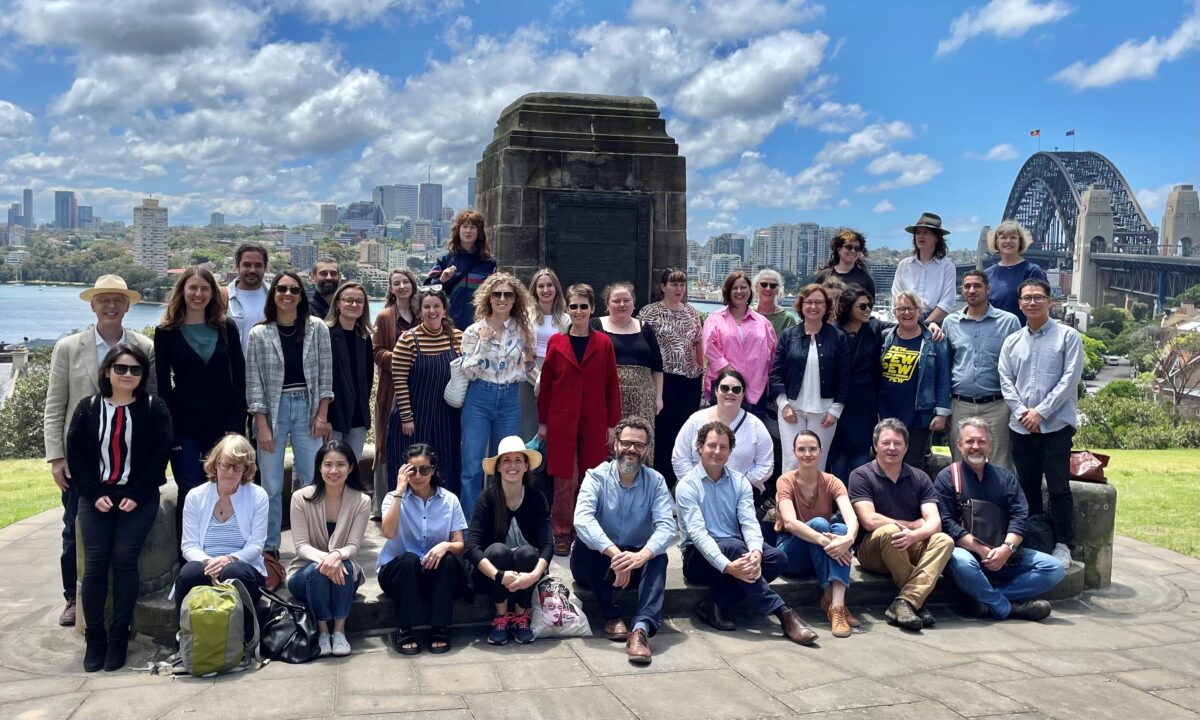
The ICS team on our way to lunch after a morning planning session, stopping off at the Boer War Memorial on Observatory Hill.
One Conservation
The year 2022 was a big one at One Conservation. We wrapped up two major archaeological artefact conservation projects and completed a collection assessment project for Monash University Library in Melbourne. Frances Paterson also had a baby! But the fun never stops and in recent months we have been busy working on some wonderful projects for our NSW clients.
Lately, Karina Acton has been working on a collection of outdoor metal sculptures for Penrith Regional Gallery and will be preparing a maintenance report to help the gallery manage the sculptures in the long term. She also recently completed a treatment of an Inge King sculpture for AGNSW in readiness for the opening of Sydney Modern. In September, she ran a sculpture care and maintenance workshop for volunteers at Norman Lindsay Gallery in the Blue Mountains. This workshop followed on from sculpture repair works carried out by Frances and our team in December 2021, and we’re excited to return to the gallery in the new year for another project with the volunteers, this time to clean some objects from their exhibition.
In between downpours this spring, we have also been continuing with the quarterly maintenance of the Martin Place Cenotaph for the City of Sydney. Major works, including cleaning, corrosion treatment, patination and waxing, were completed in late October in preparation for Remembrance Day commemorations.
O’Sullivan Conservation
Staff news
Recent months have seen O’Sullivan Conservation host its first intern, Emily Bramich, as part of her Master of Cultural Materials Conservation at the University of Melbourne. Emily subsequently accepted a full-time role as Assistant Object Conservator with us. Additionally, a new full-time Conservation Technician, Nix, commenced with us, bringing a background as a gallery assistant and a Bachelor of Fine Art from the National Art School (completed December 2022). Both are demonstrating their eagerness to learn and are proving to be valuable team members already.
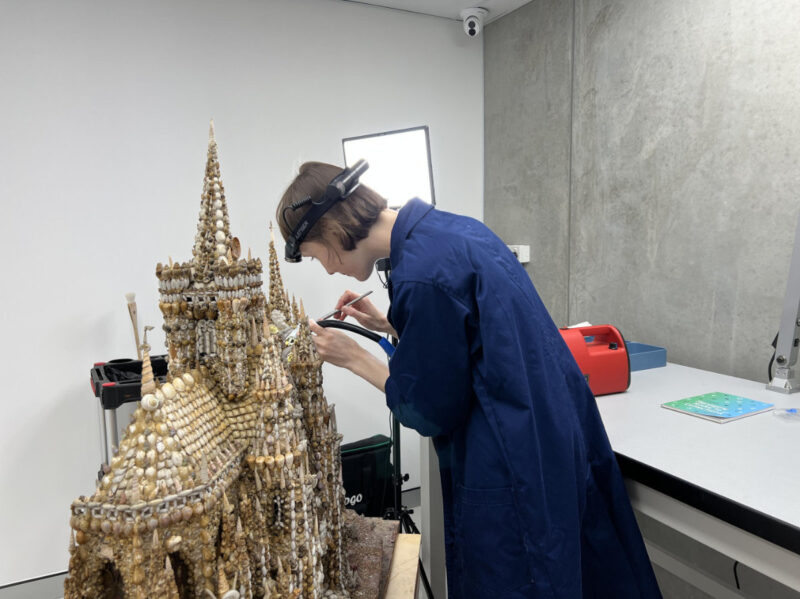
Emily focused on brush vacuuming a shell-art cathedral as part of her internship.
Professional news
On a recent trip to Scotland, Hannah and Eoin took the opportunity to catch up with senior conservators in public and private practice to review the latest methods and innovations in conservation in Europe and discuss how the industry was managing in a post-COVID world.
The IIC Wellington Congress, ‘Conservation and Change: Response, Adaptation and Leadership’, was attended by Hannah and Eoin virtually, providing great insights into the future direction of conservation.
Treatment projects
During Emily’s internship, she had the opportunity to work on an outdoor public art collection, as well as complete a conservation treatment of a shell-art cathedral, including a conservation clean and reattachment of detached components.
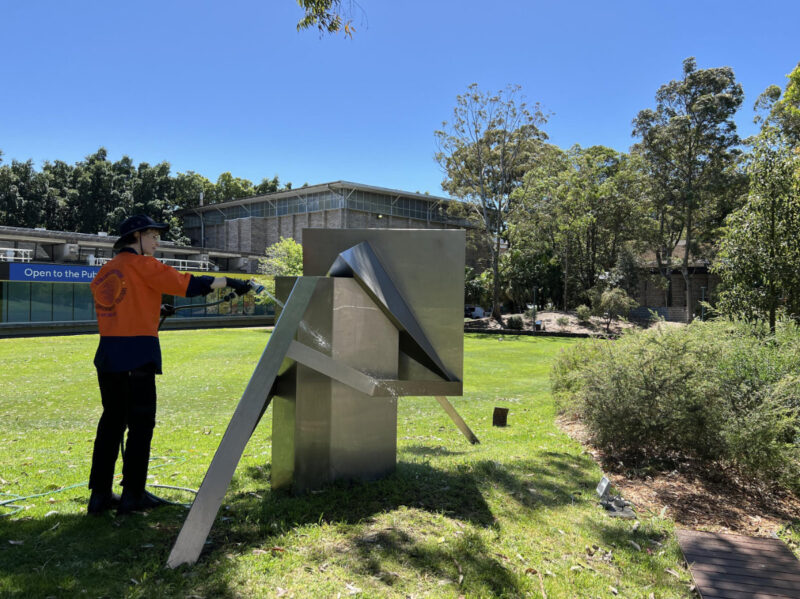
Emily cleaning a stainless-steel sculpture as part of a public art maintenance program.
The public art maintenance works continued with a major treatment of Lindy Lee’s The Garden of Cloud and Stone, Moongate, occurring in September; the team enjoyed being in Haymarket and seeing an increase in the number of people moving around the city.

Nicole heating the wax on one of the ‘flung’ bronze components of The Garden of Cloud and Stone, Lindy Lee.
Working in spectacular locations is a perk of outdoor public art conservation work, and the views do not fail to captivate at Bara on the Tarpeian Lawn at the Royal Botanic Garden, Sydney. Eoin and Nicole undertook a major maintenance treatment from height in September and managed to get a clear day.

Eoin undertaking cleaning at height of Bara.
Hannah and Eoin undertook a condition assessment of Dream City, Phillipa Playford, with Eoin and Nix subsequently returning to the site to deinstall the sculpture. Hannah continues to show a high aptitude for condition assessing and colour matching and Nix is quickly picking up hand skills as a conservation technician.

Nix accessing the inspection hatch on Dream City.
Artlab
Staff news
Sadly, we will be farewelling half of our Paper Lab colleagues at the end of 2022. Principal conservator Roberto Padoan will be moving to Sydney to take up a new role at MAAS. We will also be saying goodbye to paper conservators Laura Daenke and Amalia Ranisau as they undertake new adventures with interstate and international moves. We will miss all three dearly and wish them well in their new chapters. We also look forward to welcoming some new staff in the Paper Lab in the new year.
Several staff have been working on some interesting projects across the labs.
From Objects, Megan Sypek reports on a plaster treatment:
Working in the Objects Lab at Artlab exposes me to all sorts of items, materials, and conundrums. For some unknown reason we often go through periods of having several of the same type of item, such as Spelter horses or Murano glass. Lately, the material du jour is plaster, specifically painted religious sculptures.
I received Station of the Cross IV from a private client in a large cardboard box with many separate pieces wrapped in bubble wrap. Unwrapping revealed a partially three-dimensional image with decorative frame. A removable cross could be located at the top of the frame with a metal pin. But it was only when I tried to lift the main piece that it became clear how traumatised this item was. There were mobile cracks and blind cracks tenuously held together by a layer of hessian, which had been laid into the plaster during manufacture. This object was structurally very unstable, and I realised this would be the main hurdle of the treatment.
Initially, all the fragments were gently brush vacuumed to remove the plaster dust. I conducted solubility tests on different areas and concluded that the surface was not soluble in deionised water or white spirits, but was very soluble in acetone. After long exposure the surface was soluble in ethanol. Matte brown overpaint was easily removed from areas of the frame using ethanol, revealing faux wood-grain detailing. The remainder of the image was then cleaned with enzymes and 1% w/v tri-ammonium citrate.
Consolidation of all broken edges was carried out with an application of 5% w/v Paraloid B72™ in acetone, and blind cracks had the Paraloid B72 solution wicked in with acetone as much as possible. There were many losses and lifting flakes of paint over the image, which were consolidated using 2.5% w/v Kollotex AC 1250™ in deionised water. All fragments were adhered with a generous amount of 50% w/v Paraloid B72 in acetone. After all the existing fragments were adhered it became obvious that there were still significant losses that would require filling.
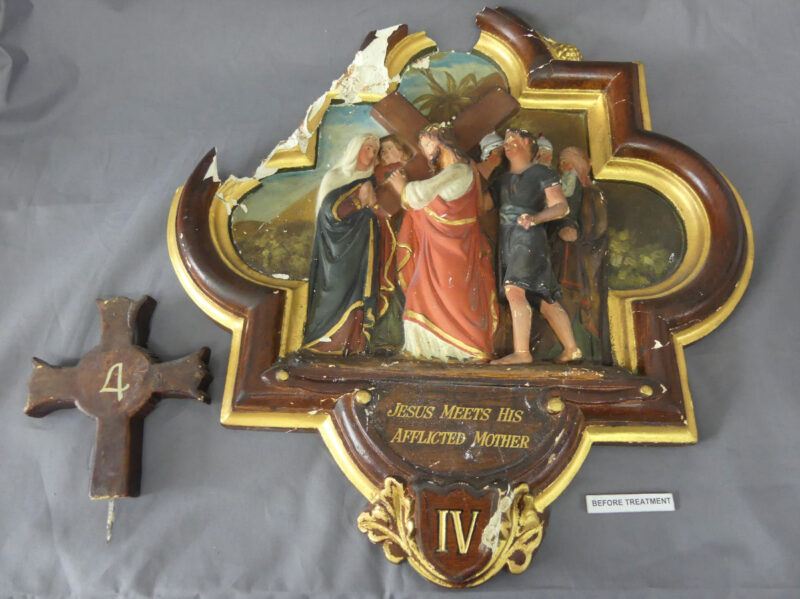
Station of the Cross IV, a painted plaster sculpture, before treatment. Image credit: Artlab Australia.
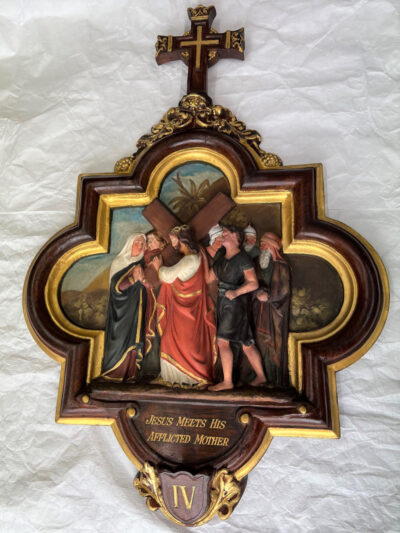
Station of the Cross IV, a painted plaster sculpture, after treatment. Image credit: Artlab Australia.
The question of reinforcing the structure now needed to be addressed. The whole item was turned face down on pillows. The original hanging ring, which was embedded in a large fragment, had now been adhered in place but required further reinforcement. Other recent Artlab treatments on plaster objects informed the next steps in the treatment. A barrier layer of 5% w/v Paraloid B72 in acetone was applied to the entire rear of the piece. Strips of Japanese tissue were then applied to the whole rear surface with 50% w/v Paraloid B72 in acetone, particularly in the channel around the perimeter of the piece. The Japanese tissue formed a barrier layer that further reinforced the piece and spanned complete losses, providing a surface on which to build up fills. Further rigidity and support were introduced to the work with the application of a layer of Free Form™ Sculpting Epoxy dough rolled out to 5mm thickness and applied over the surface. This epoxy is very light but strong, providing structure without adding too much bulk or weight.
Once the stabilisation had occurred it was a relatively straightforward job to fill, shape and in-paint losses using Liquitex modelling paste and acrylic paint. Finally, 25% w/v shellac in methylated spirits was applied to the brown frame to match the original surface patina.
Now onto the next job (painted plaster nativity figures) before Christmas! ….

Rear view of the plaster sculpture, with structural reinforcement completed. A layer of Free Form Sculpting Epoxy was applied over a barrier of Japanese tissue paper to support the unstable plaster structure. Image credit: Artlab Australia.
And from Textiles, Victoria writes about a recently completed major treatment of a silk cope:
In the Textiles Lab, we recently completed a major treatment of a cope from St Dominic’s Priory College in North Adelaide. The vestment has a particularly special embroidered ophrey featuring depictions of saints and their associated iconography. The embroidery was worked by sisters of the community of St Dominic in North Adelaide in the late 19th century and is significant both for the extraordinary needlework skill exhibited and as evidence of the commercial output of this group (as the cope was likely produced on commission).
Fortunately, the silk embroidery was (and remains) in good condition; however, the weighted silk of the cope body presented with severe splitting—typical of silk of this age. Several attempts at repair by custodians had been made over the years, some with commercial heat-set adhesive interfacing, and some stitched repairs through the lining. Initially, we thought that the silk foundation may not be original to the cope; the art nouveau style orchid pattern worked into the jacquard weave did not seem consistent with Catholic vestments of this type and age, which typically incorporate Tudor rose style patterns. In fact, an example of this more typical jacquard is present along the front edge of the cope as facing. However, upon removing the embroidered panel, we found evidence that this Tudor rose was a later addition, and no evidence suggested that the orchid-pattern jacquard was a replacement.
Following removal of the previous repairs (with thanks to our intern Freya Harrington for contributing), we completed a full adhesive lining treatment (with special thanks to the textiles team at the NGV for providing us with some additional silk crepeline in what was apparently a time of worldwide shortage). Due to the standard available width of crepeline, and for ease of application, the lining was applied in panels corresponding with the construction lines of the cope. For additional support of the splitting silk, we attached a nylon net overlay, dyed with a very slight cream tone so as to be invisible from viewing distance. The treatment proved successful, as the cope can be displayed now on a form without the risk of further mechanical damage. We also anticipate that the impact of further splitting related to inherent vice will be lessened due to the physical support of the lining and overlay.
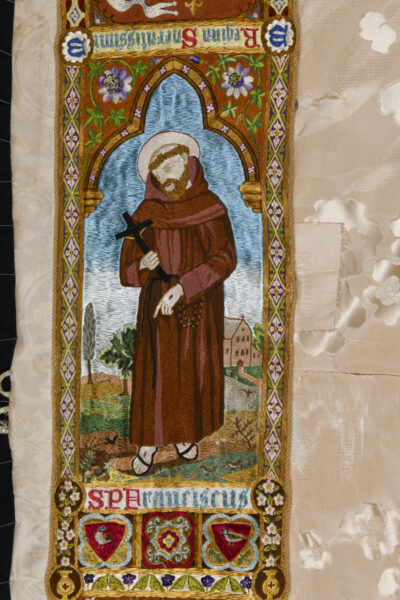
Detail of embroidery on St Dominic’s cope, with damage to the silk damask body visible along the edge of the panel. Image credit: Artlab Australia.
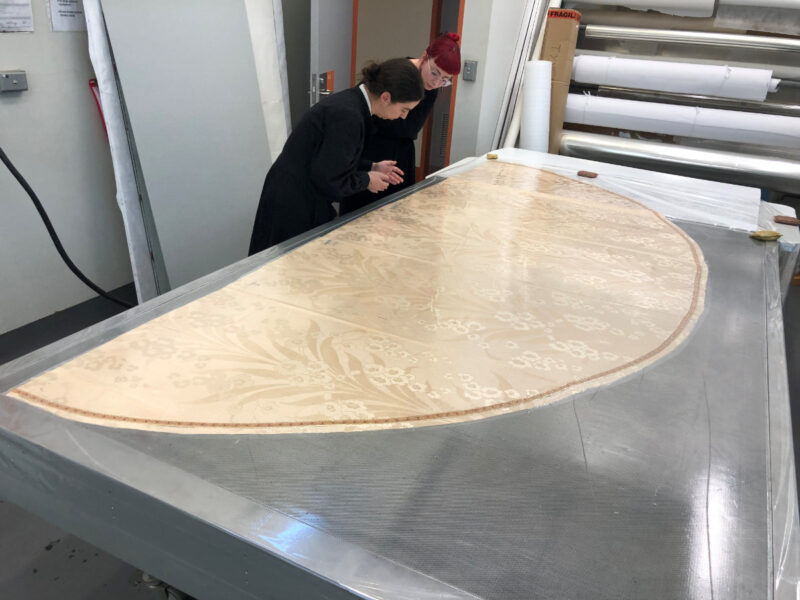
Victoria with University of Melbourne intern Freya examining the cope on the hot suction lining table. Image credit: Artlab Australia.

Detail of the cope after treatment. Image credit: Artlab Australia.

The cope on display after treatment. Image credits: Artlab Australia.
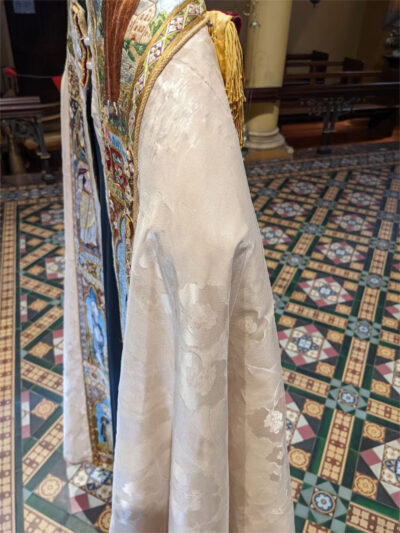
The cope on display after treatment. Image credits: Artlab Australia.
Tasmanian Museum and Art Gallery (TMAG)
In November 2022, TMAG installed the first of two anoxic showcases specifically designed for long-term display of the Museum’s collection of thylacine skins and mounted specimens. The project was developed to address the requirement for long-term display of the thylacine collection. The Museum contracted David Thurrowgood to design and develop the new anoxic system. David worked closely with Nikki King Smith, Senior Object Conservator, to install the case.
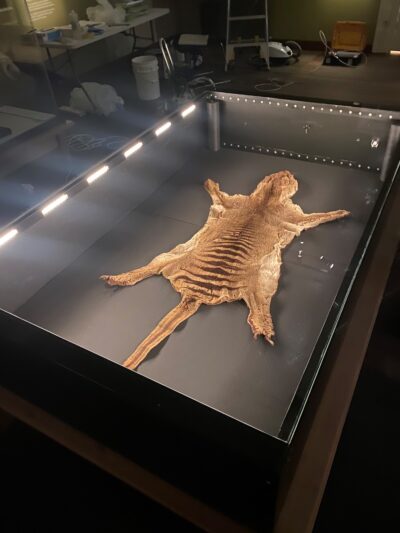
Thylacine skin in anoxic showcase.
Michelle Berry, Senior Object Conservator, has been working on the taypani milaythina-tu: Return to Country exhibition, overseeing the installation and requirements for the international loans. Some very precious items have returned temporarily to lutruwita/Tasmania including two rikawa (kelp containers), which were collected by early European exploring expeditions.
Jenny O’Connell, Senior Painting Conservator, has finished a major treatment on an 1840’s colonial portrait. Originally thought to be a portrait of a gentleman named Mr Gore, research undertaken by the curatorial team revealed it is likely to be a portrait of Mr Thomas White, a friend of the artist, Henry Mundy. With the removal of layers of discolouration and retouching old overpaint, the portrait is much more sympathetic to the subject. The treatment forms part of a larger effort to treat and research works attributed to Henry Mundy in the TMAG Collection, and will go on display at TMAG in 2023.
TMAG’s Conservation Technician, Lisa Charleston, has been occupied with the preparation of works for two upcoming exhibitions in 2023, including frame modifications, gilding repairs and fitting out of glazing. A satisfying milestone was reached with the completion of a major frame treatment involving the recreation of around 20 missing parts using a combination of traditional and modern materials and techniques.
Grimwade Centre for Cultural Materials Conservation
All staff at the Grimwade Centre were very glad to welcome our first- and second-year master’s students into the labs for the teaching of hands-on learning! Our students have continued to impress with their hard work and adaptability throughout the challenge of online and hybrid in-person/online studies. We work with many partners as our students work on real-world problems, so we thank all involved, including, to name a few, the Bendigo Art Gallery, MAMU (Music Archive Monash University), Warrnambool Art Gallery, State Library of Queensland, RSL Lifecare, Gordon Tate Geelong, Australian National Veterans Arts Museum, and Collective of Self Help Groups Victoria Collection, and we are forever grateful for the donation of artworks from the Mary Norrie (1917–2005) estate. Many of our students were able to undertake internships this semester and we are very grateful to our colleagues at Artlab Australia, Arts Centre Melbourne, Australian National Maritime Museum, Australian War Memorial, Book Conservation Services, Christchurch Art Gallery Te Puna o Waiwhetū, David Stein & Co, Grimwade Conservation Services, Museums Victoria, NSW State Archives and Records, O’Sullivan Conservation, Queensland Art Gallery|Gallery of Modern Art, State Library of Victoria, and Tartmus (Tartu Kunstimuusëum, Estonia).
Graduations and more
Several of our master’s students have completed their studies this year and will have their in-person graduation ceremonies on Wednesday 14 December at the Royal Exhibition Building, Carlton. PhDs will also be awarded including to Dr Sophie Lewincamp, who is now working as the Nyingarn Project Manager with the School of Languages and Linguistics (it is a delight to see where conservation can lead). Congratulations to all from the Grimwade Centre team; you have demonstrated exceptional dedication, resilience and flexibility over the last two years.
We are very pleased to celebrate Daniel Bornstein’s receipt of the AICCM University of Melbourne Student of the Year Award for 2022 for his scholarly and public contributions to the profession as an early career emerging conservator. Daniel’s support for fellow students and his contributions to the Grimwade student organisation SC@M and the AICCM Bulletin were particularly noted. We would also like to thank the generosity of the Australian Decorative Fine Arts Society (ADFAS) for supporting the award. As part of Daniel’s minor thesis on ‘3D Imaging of Musical Instruments: Investigating 3D imaging for heritage conservation’, he produced some quality 3D models with photogrammetry, which can be viewed here
And in relation to this we thank Professor Margaret Kartomi and the Music Archive Monash University for supporting this project.
In the next weeks we look forward to announcing the 2022 Alexander Copland Award winner for the highest achieving thesis.
Minor thesis and PhD presentations
On 21 October, master’s students presented the findings of their minor thesis projects including diverse topics such as a Ptolemaic limestone stela, the medallion decorations on Middle Eastern manuscripts, the materiality of a First Nations artefact, alternative resins for embedding paint cross-sections, evaluating Solid Phase Microextraction Gas Chromatography Mass Spectrometry (SPME GC/MS) analysis for VOCs, and the materiality of a polychromed Guanyin head.
Visiting international fellows and more
We’re very pleased to host three recent visiting fellows: Kencho Dakar, traditional master dye maker from Bhutan, Dr Kamonwan Pacaphol from Chulalongkorn University, Thailand, and Dr Ana Labrador, former head of collections at the National Museum of the Philippines.
Kencho generously shared his knowledge of dye making from plants in a series of workshops with students and professionals both at the Centre and at GCS. Dr Kamonwan Pacaphol gave a presentation on ‘Investigating sustainable nano cellulose applications in cultural heritage management’ and collaborated on teaching and research as part of the Grimwade Centre’s MOU with Chulalongkorn University.
Dr Ana Labrador joined us as a Meigunyah International Visiting Scholar in October, to present a public lecture on ‘Textile Weaving in the Philippines as Women’s Work’, conduct a master class on ‘The new ICOM museum definition of a Museum: enacting the principles, lessons, scenarios and speed humps’ and work on some timely research publications (including cultural heritage and natural disasters in the Southeast Asian region based on our earlier 5th APTCCARN Conference in the Philippines). Ana – as part of the 20-museum professional team, the International Council of Museum’s (ICOM) Standing Committee for Museum Definition, Prospects and Potentials – reminded us that Australia was consulted and agreed with the new definition. Within institutions this is a place to forefront discussions on inclusion, the right to know and representation.
Dr Nicole Tse and PhD student Seka Seniviratne were also hosted by Silpakorn University, Thailand, and the Faculty of Science in September. After a break in international travel, it was great to reconnect and continue our research with Professor Supanee Chayabutra on modern paints; be part of a conservation workshop with Ajarn Chiraporn Chayubutra and the Department of Chemistry team comprising Dr Nattawan Worawannotai, Dr Sutinee Girdthep and Dr Jitnapa Sirirak; and be part of the WiangTa Mural conservation project at the Mae Fah Luang Art and Cultural Park in Chiang Rai with Dr Chaiyosh Isavorapant and Suchata Rotjanabutr. Seka was also able to sample biodeterioration from 20th century paintings as part of her PhD on biodeterioration on acrylic paintings.
New equipment
Through the generous support of the Miegunyah Foundation, the Centre was able to buy two state-of-the-art imaging technologies: the Specim IQ hyperspectral camera and the Apollo infrared camera. The Apollo contains a cooled detector with increased sensitivity to longer infrared wavelengths along with in-camera stitching, which provides high resolution images. Students will be able to use these new systems for research and learning from next year.
Student Conservators @ Melbourne events
The Grimwade’s Student Conservators at Melbourne (SC@M) have been busy with workshops and events in the latter part of 2022. Recently they hosted the annual Jobs Panel; ‘Conserving Performance’, a masterclass with Tate’s Louise Lawson; ‘Behind the Scenes @ Melbourne Museum’, a tour of Museum Victoria’s conservation labs; ‘Intro to Book Conservation for Emerging Paper Conservators’, a bookbinding workshop with Camielle Fitzmaurice; ‘Disc Imaging Workshop’, a guide to the use of optical disc imaging in conservation with Jesse Dyer; and ‘Conservation and Cake’, an informal afternoon for practising conservation treatment skills hosted by Collingwood Conservators’ Collective.
We thank SC@M Executive Committee members Hayley Nolle (President), Jessica Argall (Vice President) and Hannah Lamond-Hallett (Secretary) for their work this year, building a strong community of students and representing the cohort.
Grimwade Conservation Services (GCS)
Conservation Treatment Awards
GCS received two awards for the conservation treatment of the world’s oldest intact Imperial processional dragon, Loong: AICCM’s Outstanding Conservation Treatment of the Year award, for the second consecutive year, as well as AMAGA’s Small Museums Award, together with the Golden Dragon Museum.
In 2021, the Golden Dragon Museum was awarded a $133,000 Living Heritage Grant from the Victorian Government to restore Loong in recognition of the dragon’s cultural and historical significance. A large team led by Dr Holly Jones-Amin and comprised of GCS objects conservators, GCS textile conservators, University of Melbourne conservation student volunteers, Bendigo Chinese Association volunteers and local conservator Jude Schahinger worked together over the past year to stabilise the 120-year-old, 40-metre-long dragon. Loong is constructed from many materials, including silk, feathers, papier-mâché, bamboo, cardboard and paper. A large part of the treatment focused on the repair of the fragile silk body and head and the cardboard scales that are attached to the silk body, and the realignment of the bamboo supports.

Grimwade Conservation Services, Loong Conservation Treatment, at the Golden Dragon Museum – Bendigo. Funded by the Victorian Government’s Living Heritage Grants. Image by Paul Burston.
You can read more about the project online at Pursuit and University of Melbourne’s News and Resources
Response to flood devastation across Victoria
In mid-October, parts of Victoria were devasted by flood waters from extensive rain that has affected the east coast of Australia in recent months. GCS conservators responded to the flood damage by offering five free zoom sessions over five weeks to anyone seeking advice on the recovery and restoration of their treasured items. To accompany these online information Q&A sessions, GCS developed a video and online resource webpage to further support those seeking advice.
GCS presented two roadshows, one in Seymour and one in Maribrynong, to provide face-to-face advice and practical demonstrations to community members. These events also provided an opportunity for University of Melbourne master’s students to assist and gain some community conservation experience.
Living Heritage Program – conservation treatment
Grimwade Conservation Services has been working with the Ballarat Mechanics Institute (BMI) on a project to conserve key elements of its Heritage Collection supported through the Victorian Government’s Living Heritage Program.
Caroline Fry and Jordi Casasayas, assisted by graduate intern Jessica Walsh, worked on the complex treatment of a mid-19th-century English painting and frame by an unknown artist with the given title Bonneted Girl with Dog. Treatment of the painting involved thread-by-thread repair of over 40 tears and losses to the canvas, varnish removal, lining and retouching. The frame treatment involved removal of discoloured bronze overpaint, moulding repairs and adjustment to the presentation of gilding. The resulting treatment has transformed both painting and frame, which had been described previously as ‘untreatable’, to a delightful genre painting, which will be prominently displayed in the Ballarat Mechanics Institute’s heritage interior.
The Paper team’s Katy Glen, Peter Mitchelson, Libby Melzer, Noni Zachri, and student volunteers Hayley Nolle, Julia Silvester and Emma Dacey, have been working on items from the BMI’s Baron Ferdinand von Mueller Collection including rare books and an exceptionally fragile and significant collection of 215 19th-century botanical specimens. GCS worked with the National Herbarium of Victoria to develop protocols for the repair, stabilisation, and rehousing of the specimens into custom trays in Solander boxes so the specimens can be safely handled and displayed as part of BMI regular public programs.
International Conservation Services (ICS) Melbourne
ICS Melbourne has been full steam ahead for the past three months, with big projects happening and exciting changes to our team.
We are thrilled to have Eden Christian join us from ICS Sydney. Eden will be taking over from Kristine Allinson, who is now on maternity leave. Eden specialises in paintings but is branching out into the world of project management.
We have also welcomed Stefano Cannone to ICS Melbourne and are excited to see what he will contribute to the team. Stefano is an Italian-trained conservator with experience in paintings and objects. He recently moved to Australia from Italy and will be taking on a permanent role in early 2023.
During the last quarter of the year, Katie Smith and Kristine Allinson worked tirelessly over several trips to conserve and restore a ship mural at J Ward Museum in Ararat.
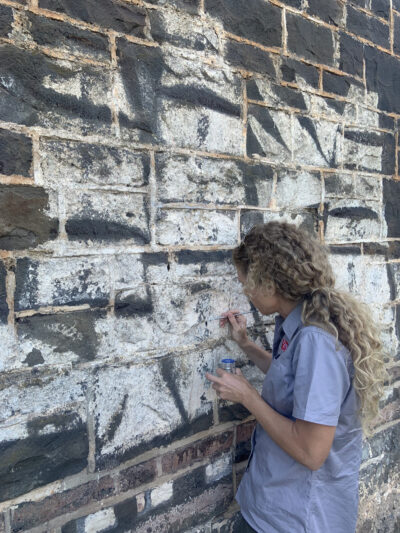
Katie Smith testing consolidation methods on the mural before commencing treatment. Image credit: International Conservation Services.
The treatment involved making repairs to the mortar around the mural as well as cleaning, consolidation, and inpainting to the mural itself. The Friends of J Ward were thrilled with the result.

The mural before treatment. Image credit: International Conservation Services.

The mural after treatment. Image credit: International Conservation Services.
The team recently undertook an investigation into the structural stability of an iconic Melbourne sculpture, identifying the need for significant structural and stabilisation works over the coming months.
Katie Smith and Richard Silink of ICS Sydney have joined forces to assess the feasibility of relocating various murals and a Nissen hut within a development site west of Melbourne.
Kristine Allinson and Sarah Neaves have been managing numerous small projects for private and institutional clients, including paper artworks, prints, paintings, and textiles.
Bruno Bell has recently treated a number of trophies for the Australian Sports Museum, while Katie Smith and Kristine Allinson reported on the lifespan of a significant textile, also housed in the museum.
Katie undertook a treatment on a beautiful, gilded frame for Beleura House and Garden, cleaning and restoring losses to the decorative ornament.
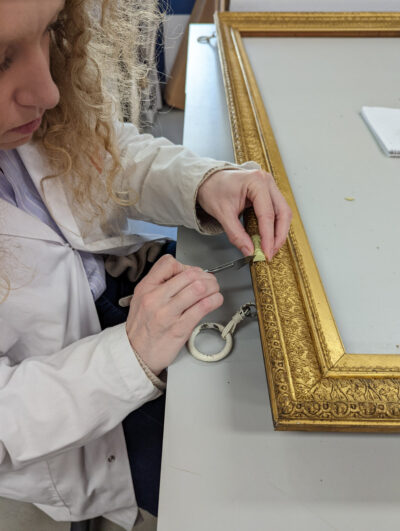
Katie Smith repairing losses to the frame. Image credit: International Conservation Services.
Katie Smith and Bruno Bell worked together on a bronze sculpture for the Shrine of Remembrance just in time for Remembrance Day.
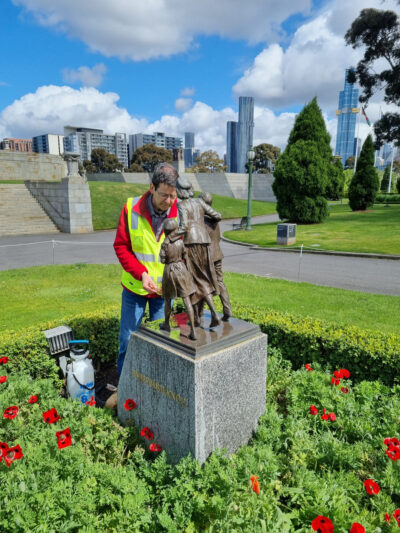
Bruno Bell cleaning the Widow and Children bronze at the steps of the Shrine of Remembrance. Image credit: International Conservation Services.
Eden Christian and Stefano Cannone are about to commence their first major project together here in Melbourne, conserving a severely damaged historic paper ceiling at a local municipal building. The project involves the stabilisation of as much of the original paper as can be salvaged and reconciliation between the original and replacement papers.
We have now said farewell to Bruno Bell as he leaves ICS to pursue a business in horology after completing his studies through the British Horological Institute. The team at ICS Melbourne wishes him the best of luck in his new endeavour.
National Gallery of Victoria (NGV)
General
Michael Varcoe-Cocks, Associate Director, Conservation, has been busy in his role on the steering committee of the design team for NGV-C. As part of the NGV-C developments, the Conservation department will be largely relocated to a temporary space on-site at NGV-I throughout the years of construction. Conservation Project Assistant Manon Mikolaitis has been assisting Michael in preparation for the relocation and has also been assisting with the auditing, collection management, and preservation planning of the NGV’s time-based media collection.
Michael and the team have also been working collaboratively with scientists from the Los Angeles-based Getty Conservation Institute (GCI), undertaking research into museum environments using acoustic emission technology to monitor hygroscopic materials and the influence of broader environmental parameters on artworks.
MaryJo Lelyveld, Manager, Conservation, and Rahila Merchant, Project Assistant, Conservation and Collections, have been busy working on preventive conservation activities, including monitoring incidents and collection environments of exhibitions, and updating disaster preparedness response procedures.
Through the generous funding from the Bank of America Art Conservation Project, we welcome Genevieve Sullivan to the team as Conservator of Indigenous Art. Genevieve will be providing care and conservation of important Western Desert artworks in the NGV Collection, created in the 1970s and ’80s by the Papunya and Lajamanu communities. The project utilises a holistic preservation strategy, which draws upon the values and guidance of the Lajamanu and Papunya peoples in addition to the physical needs of the works so that they can be displayed.
Members from the department have also hosted material speciality webinars for members of the Public Galleries Association of Victoria (PGAV) focusing on the care of fashion-based collections, decorative arts and furniture, time-based media works, and loans, as well as the use of display and storage materials, and sustainability and collection care practices.
Paintings
The NGV Paintings team has continued its busy treatment program with ongoing major treatments such as Raymonda Rajkowski’s structural and surface treatment of Peter Upward’s Untitled (Blue) and Carl Villis’ inpainting work on Murillo’s Immaculate Conception. Raye Collins has commenced removal of varnish and overpaint from James Tissot’s An Interesting Story (c. 1872), whilst Caitlin Breare has similarly begun to clean layers of varnish and overpaint from the NGV’s portrait of Rembrandt by a member of Rembrandt’s studio. Caitlin had the opportunity to carry out some invaluable research on Rembrandt during a visit to Amsterdam in October whilst she was there to attend the APPEAR Project Concluding Conference organised by the J. Paul Getty Museum and the Allard Pierson Museum at the University of Amsterdam. This conference examined the findings from the nine-year international collaborative project into ancient Romano-Egyptian funerary portraits, including the seven works in the NGV Collection. In November, Raymonda Rajkowski flew to Paris to unstretch and supervise the re-crating of two large canvases by Sally Gabori lent to the Fondation Cartier. Both paintings will next head to Milan for the second leg of the exhibition.
Another ongoing project involving the paintings team includes an environmental monitoring exercise of the buffering capabilities of a variety of transport crate types that have been exposed to major fluctuations of temperature and relative humidity. This project is part of the NGV’s review of its crate specifications for works of art going out on loan.
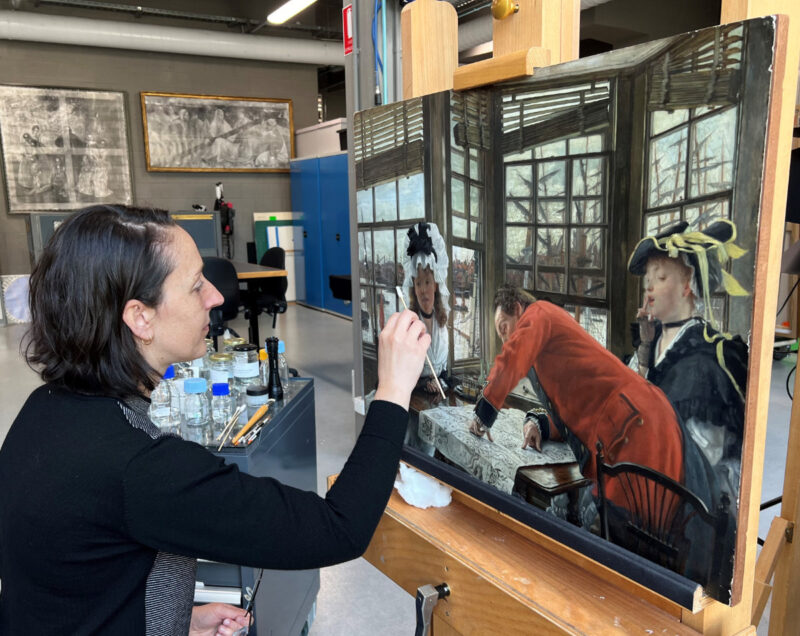
Raye Collins cleaning James Tissot’s An Interesting Story (c. 1872). Image credit: Carl Villis.
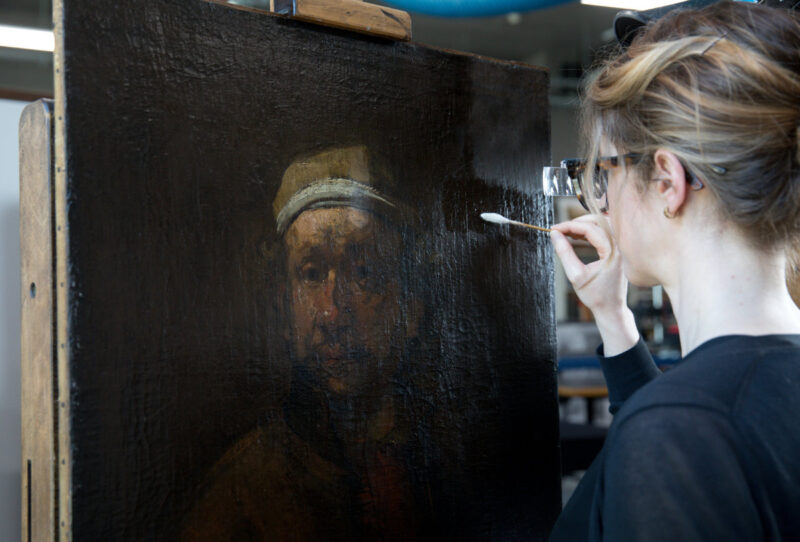
Caitlin Breare removing discoloured varnish and overpaints from the NGV’s Portrait of Rembrandt by Workshop of Rembrandt van Rijn. Image credit: NGV Photographic Services.
Frames and Furniture
Suzi Shaw has been preparing works for ‘The Global Life of Design’ as well as ‘China – The Past is Present’, and relishing the opportunity to study and prepare a Japanese clock acquired in the 1920s, and numerous Chinese carved lacquers. One dish was acquired in 1867, making it one of the earliest Asian art acquisitions for the Gallery. This artwork had two detached pieces, which provided a chance to examine the carving in cross-section, noting the different coloured lacquer layers to help guide the depth of carving for the background ‘diaper’ patterns and the raised ornament.
Holly McGowan-Jackson is in the final stages of the major frame treatment for Charles Cope’s The Pilgrim Fathers: Departure of a Puritan Family for New England, which has involved a team of conservators and technicians working on and off over the last couple of years. In July and August, Jen Parker completed the recreation of the missing corner acanthus leaves and worked with Holly to complete the remaining Modostuc fills. Holly completed cleaning the frame front and undertook stabilisation of the verso and mitres in preparation for the addition of timber blocks and steel bracing, which will enable the frame to be reassembled. The structural work is being undertaken by the NGV’s Senior Conservation Art Technicians Eamon O’Toole and Gervais Battour. Holly and Suzi have been inpainting in preparation for the final areas of ingilding. To complete the project, Jason King, Frame maker, has made and gilded a reproduction slip for the frame. We can’t wait to see all the parts together again!
Paper and Photography
In the Paper and Photographs conservation studio Bonnie Hearn has been preparing a group of Chinese papercut portraits of Chairman Mao for display in ‘China – The Past is Present’, on display at NGV-I until 14 May 2023. The papercuts are cut from a red-dyed paper, possibly hand dyed and potentially light-sensitive. Bonnie has taken colour readings using an X-Rite spectrophotometer to monitor any colour shifts over time.
The studio has been fortunate to have Robyn McPherson assisting with packaging new acquisitions in readiness for storage. Robyn is currently packing a group of Graeme King lithographs dating from the 1960s to the 1980s. The studio uses many different systems for storing works on paper and, in this case, the prints will be interleaved with glassine and stored in custom-made folders within a Solander box; when required for display, they will be mounted.

Robyn McPherson housing a group of Graeme King lithographs. Image credit: Louise Wilson.
Louise Wilson has been examining a group of recently acquired drawings produced by Fred Williams in London in the 1950s. The drawings were donated to the NGV by Lyn Williams and many of them are included in ‘Fred Williams: the London drawings’ which is on display at NGV-A until 29 January 2023. Louise wrote an essay on the materials and techniques of the drawings for the exhibition catalogue, outlining the impact of post-war rationing and the poverty of Williams’ circumstances on the materials used.
Ruth Shervington has been treating a range of watercolours produced by artists based in Hermannsburg, including many beautiful works by Albert Namatjira and his sons. The works were recently donated to the NGV, and Ruth is undertaking a range of treatments including backing removals in preparation for display of the works at NGV-A in 2023. Ruth has also been liaising with numerous photographic artists regarding framing their works for display in ‘Melbourne Now’, which opens at NGV-A in March 2023. Ruth has also carried out virtual courier activities with the Smithsonian Museum of Art in Washington for a group of Indian miniatures that are included in their exhibition ‘A Splendid Land: Royal Paintings of Udaipur’.
Textiles
Textiles conservation is in the midst of a particularly busy time, condition reporting and dressing the fashion exhibition ‘Alexander McQueen: Mind, Mythos, Muse’, which will open on 11 December 2022 at NGV International.
The Textiles conservation team, comprising Skye Firth, Ellen Doyle, Bella Lipson-Smith and Kate Douglas, is being joined by an extended team of external contractors including three textiles conservators and four mannequinage specialists.
The exhibition includes over 140 mannequins, which is a huge logistical undertaking!! Some costumes in the exhibition are being loaned from the Los Angeles County Museum of Art (LACMA), but almost half of the works are from the NGV’s extensive collection of McQueen garments.
Meanwhile, there are a number of collection changeovers and exhibitions at NGV-I that will be installed before the end of the year, and we are working towards ‘Melbourne Now’ and a large loan exhibition that will head to Bendigo, both of which are happening in the first half of next year.
Exhibitions
The Exhibitions Conservation team attended and contributed to the AICCM Exhibitions SIG Symposium 2022 ‘Exhibitions: Inclusive and Sustainable Practices’. Catherine Earley spoke about remote streaming for virtual condition reporting, and Janelle Borig and Camielle Fitzmaurice presented a case study of the documentation used to scope and install our latest Melbourne Winter Masterpiece show ‘The Picasso Century’. They thoroughly enjoyed the symposium and were especially impressed by the sustainable exhibition case study presented by Choi Sangho from the Museum of Contemporary Art in Busan, Korea.
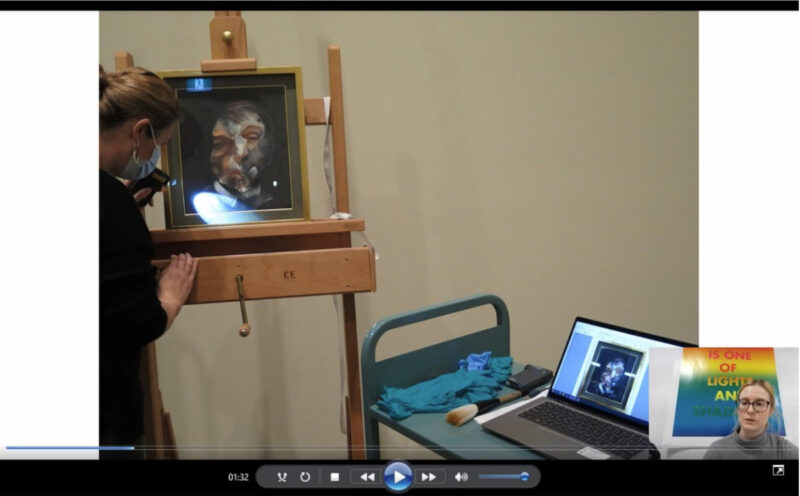
Exhibitions conservator Janelle Borig examines a painting against its ArtReport digital documentation. Image credit: NGV Conservation Department.
The team has also been busy deinstalling ‘The Picasso Century’ and will have a busy end to the year focusing on our summer show, ‘Alexander McQueen: Mind, Mythos, Muse’, in partnership with LACMA.
State Library Victoria, Collection Care
Social news
Collection Care has been busy across social media channels. We wrapped up the hugely successful A–Z Instagram series in September, with fortnightly posts covering topics from archival packaging and the proper use of gloves to hazardous materials and the beauty of Japanese tools. On Friday 4 November, Collection Care staff once again participated in #AskAConservator Day, responding to a range of questions from the public on Instagram Stories and Twitter. On the blog, Preservation staff provided insights into the Library’s Collection Disaster Response Program for International Day for Disaster Risk Reduction, and shared information and resources to assist Victorian communities affected by the recent floods: How to protect and salvage your flood-damaged treasures.
Staff changes
Emily Keppel was recently appointed Conservator, Books, and Christine Mizzi was made an ongoing member of the Preservation team.
Preservation Technician Jeff Harrison resigned after many years of rehousing sheriff writs, vinyl records, thousands of images of ships, buses and aerial landscapes, constructing phase boxes and covering hundreds of dust-jacketed books. We wish him well.
In September we also said a temporary goodbye to Paper Conservator Jessica McElhinney who has welcomed a beautiful new addition to the family. Congratulations to all!
Events
In August, Katy Glen represented Conservation on the National Science Week panel Women in Science at the Library alongside Senior Librarian Anna Welch and Senior Curator Linda Short, and moderated by science communicator Upulie Divisekera. Katy spoke to a live audience of approximately 180 (streamed to many more) about her work, with a particular focus on photographs and how we care for them.
Conservation hosted two student placements from the University of Melbourne’s Master of Cultural Materials Conservation program recently. Daniel Bornstein and Michael Iles worked across the Collection Care branch.
Collection Care staff organised a visit to the Royal Botanic Gardens (RBG) Victoria Herbarium to learn about the preparation of botanical specimens to inform several Collection Care projects. Mounting techniques demonstrated during the visit have since been adapted by Katy Glen and Leah Williams to secure 14 loose, fragile specimens from the Allan McEvey manuscript collection. We look forward to a reciprocal visit by the Herbarium staff soon.
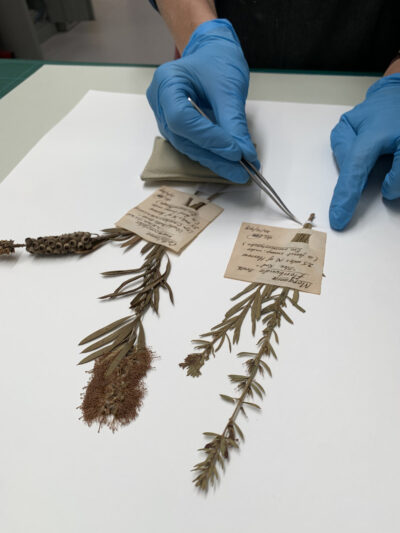
Mounting botanical specimens from Allan McEvey Papers (YMS 16315), State Library Victoria. Image credit: Leah Williams.
In October, Collection Care enjoyed site visits from professional colleagues. Robin Hodgson (RH Engineering) showcased the new infrared (IR) heat tool, which Conservation is currently trialling with great results for pressure-sensitive adhesive tape removal. We thank Rosemary Goodall, Materials Scientist from Museums Victoria, who kindly tested a selection of collection items for hazardous materials using X-ray fluorescence (XRF). Several botanical specimens were found to contain mercuric chloride, while one green 19th-century book cloth tested positive for copper acetoarsenite (emerald green pigment). Staff continue to survey the collection for hazards, and work is underway to determine best storage and handling practices for these materials.
Treatment projects
Preservation completed treatment of five Victorian newspaper titles prior to digitisation of 53 volumes and a total of 19,000 pages. Beginning in 2019, this project was interrupted by multiple COVID-related disruptions. Congratulations to Josh Cassidy, Jessye Wdowin-McGregor and Christine Mizzi for their perseverance and pragmatism. The volumes are now with Digital Production for capture and will soon be available to the public on Trove.
Kate Holloway repaired a badly damaged front page of the first edition of The Euroa Gazette (1897) in preparation for image capture as part of the newspaper’s 125th anniversary celebrations. This was featured in internal and external media events, including an article in the Gazette itself.

First page of The Euroa Gazette before treatment (barcode no. 30378114250771), State Library Victoria. Image credit: Kate Holloway.
Rehousing work was completed on the extraordinary archive of bohemian artist Vali Myers. A range of custom housing solutions was devised by Savina Hopkins for visual diaries, objects, drawings, posters, artworks, photographic material, and personal effects. Digitisation of items from the collection is now underway. The visual diaries can be viewed online, alongside 50+ artworks. Watch this video for a peek behind the scenes.
This month also saw the completion of the conservation treatment and rehousing of an album of 87 Robert Russell sketches by Marika Kocsis. Due to the extremely poor condition of the album (compiled by a family member) and the discovery that many drawings were double-sided, it was decided, in consultation with collection staff, to remove the sketches, allowing them to be safely and accurately catalogued.

Robert Russell album showing five works, before treatment (left) and one sketch, after treatment, with printed image of verso (right) (pre-accession), Pictures Collection, State Library Victoria. Image credit: Marika Kocsis & Albertine Hamilton.
Exhibitions
Conservation is preparing for the next annual rotation of the Library’s permanent exhibition ‘World of the Book’, which will open in Autumn of 2023. This includes preparing items from the magnificent collection of Egyptology books. Simultaneously, Conservation is working on a large digital exhibition of the Emmerson collection. This has involved the preparation of over 80 items for digital capture, including 3D photogrammetry of several decorative bindings, with exciting results.
Conference attendance
Albertine Hamilton is nearing the end of the Getty’s Paper Project program ‘Color on Paper’. To date, she has attended five of six online seminars and discussion groups, covering topics from the function of colour in Renaissance Italy and the innovative use of aquatints for reproducing and interpreting drawings, to the materials and techniques of Japanese woodblock prints and Iranian book arts. Albertine is excited to visit the Getty in LA to complete the residency component from 26 February to 3 March 2023.
Ian Macleod
After Ian finished his work on a 17th century shipwreck in Croatia (more details in the previous e-News), he then was off to Turkey to work with Dr Alice Paterikis and one of her interns from the UCLA training program. Whilst there, he was the only one on the team who managed to escape COVID. In September, he attended the ICOM-CC Metals working group conference in Helsinki and, of the 300 attendees in-person and online, he was the only delegate who has attended all ten interim metals meetings. In the week following, he gave a series of lectures and workshops at the National Museum conservation and collections facility at Vantaa, Finland. In November, Ian presented the story of the preservation of textiles on one of several hundred exhumed bodies from East Perth Cemeteries to the Australasian Corrosion Association round-table conference at the Duke of Wellington Hotel in Melbourne’s CBD.
Historic Textile Collection of the Embroiderers’ Guild of WA
This has been a year of mixed fortunes. At the end of 2021, we received an excellent report: ‘Significance Assessment of the Collection’. In 2022, we were successful in our applications for three grants – one from The Copeland Foundation for archival boxes, one from AMAGA/Chart ($3,000) for Dexion shelving and a laptop for Mosaic database, and one for BAC storage cabinets – for which we are most grateful.
Extensions are being designed for Guild House, and planning began for a temporary move while building is under way. However, the extension, dependent on a grant, is still in the pipeline and builders are in short supply. We remain ready when the time is right and appreciate the patience of all our supporters.
Our leader, Valerie Cavill, was awarded the individual WA History Council Award ‘for her work in collecting, preserving and advocating for the place of needle art in the canon of Western Australian history. This is an often-overlooked aspect of the domestic and material culture of WA.’ We are very pleased that her 25 years’ service to the Collection has been acknowledged.
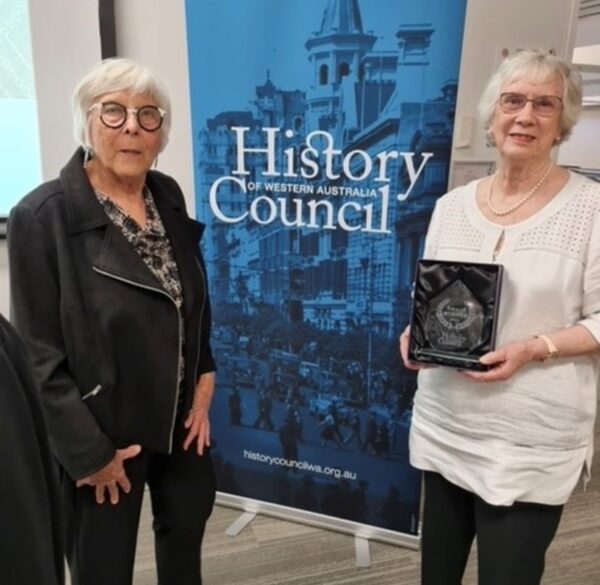
Valerie Cavill receiving her individual WA History Council award. Image courtesy of the Embroiderers’ Guild of WA.
ICS Perth
Claire Rowson has been back and forth to the ICS Sydney office to finalise various projects on the east coast, but is settling into some meaningful conservation projects in WA. She has been busy assessing private collections and recommending maintenance and remedial treatments for bronze and stone outdoor sculpture. Her final engagement before Christmas will be updating the Disaster Preparedness Plan for the Royal Historical Society of Western Australia. Claire will kick off 2023 with a mural conservation project at the Fremantle Prison.
Woodism
Marco Pansini has recently completed a challenging restoration of the Bishop Hale kneeler for the Hale School in Perth. Matthew Blagden Hale (1811–1895) was consecrated Bishop of Perth in England in 1857 and returned to Western Australia in 1858 where he established the first Anglican diocese of Perth and the Hale School. The kneeler was made around this time, making it one of the earliest pieces of fine furniture produced in WA. This makes the kneeler not only a fine example of furniture making and joinery but also an object of state and national significance.
The process of reconstruction was very delicate and required several stages in order to retain the unique angles and shape of the kneeler. The barley twists, which are the spiral-shaped uprights, had to be completely refabricated as the originals were broken in several parts and beyond repair. The frame components also had to be rebuilt as a consequence of the repetitive hammering of studs and nails caused by several reupholstery jobs over the years.
The photos show a wonderful result—well done Marco on the preservation of a very significant piece of Western Australian history!

Before and after treatment images of the Hale School Bishop Kneeler. Images courtesy of Marco Pansini.